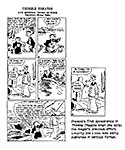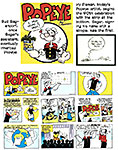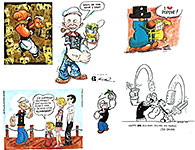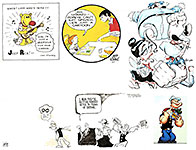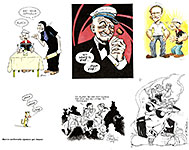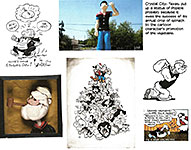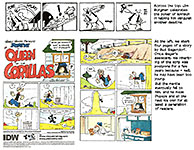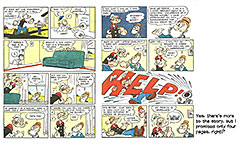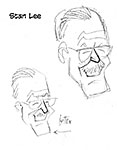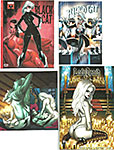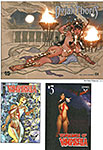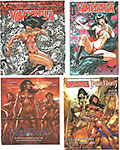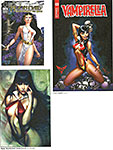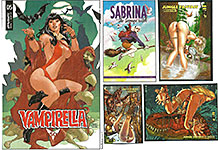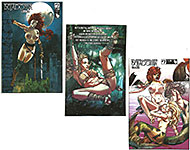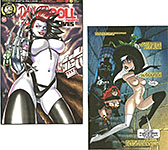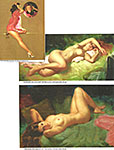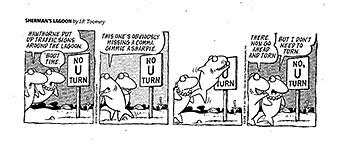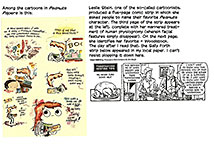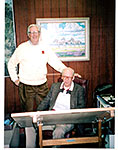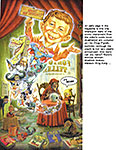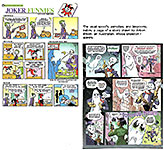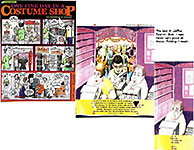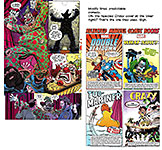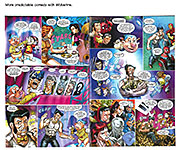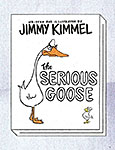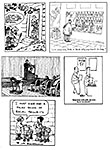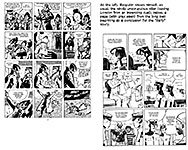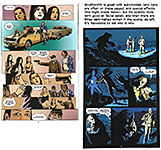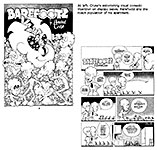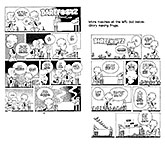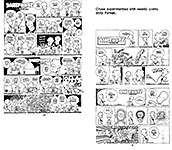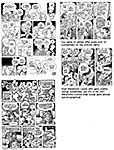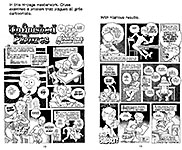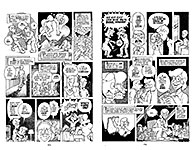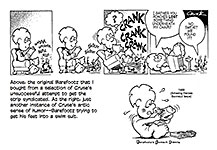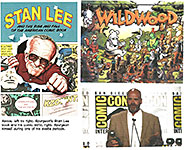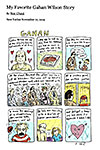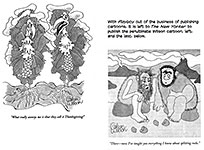 |
||||||||||||||||||||||||||||||||||||
Opus 399 (December 17, 2019). Play the oboe and bagpipes merrily—it’s time for our anyule extravaganza, for which we include a wildly illustrated celebration of Popeye’s 90th birthday. We also contemplate Playboy-like covers of comicbooks (the end of the year signaling, as it used to, the emergence of a fresh crop of calendar girls) and editoonery coverage of The Impeachment and Alan Moore’s beard and hair. We review the end of Mad and the start of Crazy, Peanuts Papers, the awful finale of tv’s “Watchmen,” graphic novels Corto Maltese: The Early Years and Stumptown, and IDW’s Dick Tracy, plus long, appreciative obits for Howard Cruse, Gahan Wilson, and Tom Spurgeon. Here, cryptically, is what’s here, in order, by department—:
NOUS R US Back Issue Biz Booming Lendelof’s “Watchmen” Ends Awfully Clifford Starts a New Television Adventure Mankoff’s New Gig Zapiro Gets French Award Lynda Barry in Family Circus Alan Moore says He’ll Be Voting This Time Drag Show at Comics Store Heroes in a Paper Bag
FUNNYBOOK FAN FARE Trees: Three Fates
Short Ribs Jughead the Hunger vs Vampironica Gunning for Hits Dying Is Easy Yondu Moonshine Pretty Deadly: The Rat Dick Tracy (Two Versions)
ANNIVERSARIES Berlin Wall Bonanza
TRUMPERIES More Antics of the Chief Idiot
EDITOONERY Surveying the Political Cartoons of the Past Month
THE FROTH ESTATE Shepard Smith Retires
NEWSPAPER COMICS PAGE VIGIL Odd, Profane, and Obscene Content in Today’s Funnies
POPEYE IS 90 And Thimble Theatre Is 100
RANCID RAVES GALLERY Previews Catalogue and Playboy Pinups Sexual Adventures on Comicbook Covers and Inside Moran Pinups BOOK MARQUEE Reviews of—: Peanut Papers End of Mad; Start of Crazy The Serious Goose by Jimmy Kimmel Kent State Killing in Graphic Novel
BOTTOM LINERS Gag Cartoons
LONG FORM PAGINATED CARTOON STRIPS Graphic Novels Reviewed—: Corto Maltese Early Years Stumptown
ONWARD, THE SPREADING PUNDITRY Impeaching the Trumpet Some More
PASSIN’ THROUGH Howard Cruse Gahan Wilson Tom Spurgeon Lew Little
QUOTE OF THE MONTH If Not of A Lifetime “Goddamn it, you’ve got to be kind.”—Kurt Vonnegut
Our Motto: It takes all kinds. Live and let live. Wear glasses if you need ’em. But it’s hard to live by this axiom in the Age of Tea Baggers, so we’ve added another motto: Seven days without comics makes one weak. (You can’t have too many mottos.)
And in the same spirit, here’s—: Chatter matters, so let’s keep talking about comics.
And our customary reminder: don’t forget to activate the “Bathroom Button” by clicking on the “print friendly version” so you can print off a copy of just this installment for reading later, at your leisure while enthroned. Without further adieu, then, here we go—:
NOUS R US Some of All the News That Gives Us Fits
BACK ISSUE BIZ IS BOOMING "Back issues sales are definitely up, and have been a growing piece of our business for the last 2-3 years running, after a long lull," Joe Field of Flying Colors Comics in Concord, California told Jim McLauchlin at ICv2.com. But the traditional, gotta-have-’em all collector seems to be a dying breed. "There is more activity in first appearances of characters, of maybe collecting specific artists or writers," Field continued. "But in terms of collecting things to have a complete collection— I really think the publishers have blown that market up by constant restarts and doing 'seasons' rather than long-running series." The scene looks the same to Carr D’Angelo, who owns the two Earth-2 stores in Los Angeles. "There's still that classic guy with his list out there, and he’s buying only the issues he needs to fill in his run, and I love that guy," D'Angelo said. "But I think there are more people buying back issues just because it brings them joy." "There is the return of speculators," D'Angelo continued. "There are day-traders dedicated to the idea of flipping comics, literally flipping them in a day. They want to buy Once and Future from BOOM! Studios for $4 that day, and sell it for $10 on eBay that night. I dunno. You can't even buy lunch with what you made after eBay fees and all, but there are definitely those speculators." That very word "speculative" is a dirty one to some retailers. But collector Nick Coglianese thinks those people are fighting the wrong enemy. "A lot of people shit on speculators, but I kind of look at the comic industry as this giant, three-pole tent," he says. "Your poles propping it up are the readers, the collectors, and the speculators. They're all contributing to the industry. They're all holding up their part of that tent. And if one goes… no one wants to see that. People might say, 'I hate speculators; I want to see them go away.' Well, if they went away, that's one big chunk of comics revenue that goes away with it."
WATCHMEN ENDS—AWFULLY I watched the last installment of Damon Lendelof’s “Watchmen,” hoping the finale would tie together all the loose ends of the series and somehow thereby rescue the whole muddling- through production. Alas, that didn’t happen. The last chapter was as disappointing as the first and all those in between. Nothing that we now know or think we know makes any of the meandering menace of twist upon twist any clearer at the end than it was at the beginning or anywhere along the way. Throughout, we don’t have a clear notion of who the good guys are and who the bad guys are. At times, Lendelof’s “Watchmen” seems to incorporate some sort of racial warfare complete with Ku Klux Klanners of its own. But what happened to the Seventh Kavalry? Dunno. The only constants are Regina King as Angela Abar, aka the hooded Sister Knight, and Jeremy Irons as Adrian Veidt aka Ozymandias, who seems a sort of villain. But Veidt is still standing at the end. Dr. Manhattan, who hovers over the whole series as a blue super-powered good guy, finally shows up only to dissolve with a bang, leaving Abar pondering her fate and Veidt still smirking, knowingly (but without letting us in on the secret). The end is fraught with this sort of smirking. Louis Gossett, Jr., seems to know why he’s smirking, but he doesn’t tell us. “To make an omelet,” he murmurs, cryptically, “—you have to break some eggs.” Now, there’s a brilliant observation. How did Lendelof come up with that one? So the meaning of his production rests on a tired old piece of folk wisdom? Then we are treated to a few choruses of “Oh, What a Beautiful Morning” from “Oklahoma” (ironic because this story is set in Tulsa, Oklahoma, where the nation’s worst race riot took place in the 1920s). I know the songs in “Oklahoma” better than I know anything. My father bought a 33 rpm record player when I was about ten (that would be in about 1947), and for some time thereafter, the only long-playing record we had (the only one we could afford for a while) was that of the songs of “Oklahoma.” But my grasp of these timeless lyrics shed no light on the ending of Lendelof’s “Watchmen.” Then Abar breaks the only egg that has somehow survived the smashing of a carton of eggs, eats it raw (because Gossett told her “you are what you eat” or some such snatch of wisdom), and then, to see if eating raw egg will enable her to walk on water, puts her foot out over a swimming pool. She’s about to step down when—. Poof. The whole thing ends and credits crawl up the screen. We are left in ignorance about whether Sister Knight can walk on water or not. “I’ve got a beautiful feeling, everything’s comin’ my way.” I’m majorly baffled. Smart people and knowledgeable critics all think Lendelof has produced a masterpiece. I can’t see it. Instead, what we get is a lot of looming allusion, motif after motif, and twist upon twist until the whole narrative is knotted beyond unraveling. The thing about allusions is that they must be made to mean something: it’s not enough to just sing songs from “Oklahoma” during the racist 1920s in Tulsa. So what? Is that good or bad? What are we supposed to think about it? Or is the whole point just irony? And the connection to Alan Moore’s “Watchmen” is likewise beyond my keen. Apart from a few characters—Dr. Manhattan, Ozymandias—there is no obvious connection in theme or plotline. But people will be talking about this thing forever. “I’ve got a beautiful feeling, everything’s comin’ my way.” Phooey.
CLIFFORD STARTS A NEW TELEVISION ADVENTURE Scholastic Entertainment is debuting a brand-new Clifford the Big Red Dog tv series, based on the Norman Bridwell books. It premiered on Amazon Prime Video on December 6, reported Karen Raugust at publishersweekly.com, and on PBS Kids on December 7. The new series is the third for Clifford, after the original Clifford the Big Red Dog, which aired on PBS from 2000 to 2003, and the spin-off Clifford’s Puppy Days, which PBS carried from 2003 to 2006. The new series consists of 39 22-minute episodes over three seasons, each featuring two 11-minute stories, and will be doled out in two drops per season of six to seven episodes each. The new show differs from the original in several ways, according to Caitlin Friedman, senior v-p and general manager of Scholastic Entertainment and co-executive producer on the series. “Emily Elizabeth and Clifford can speak to each other, which they never did before,” she said. “And Emily Elizabeth drives the action this time, along with Clifford. They’re in it together.”
MANKOFF’S NEW GIG Reveals That He Was Fired Bob Mankoff, once cartoon editor at The New Yorker, is now peddling cartoons through CartoonCollections, where interested parties can buy cartoons off the Web. The operation is an invention of Mankoff’s, who introduced it under another name—Cartoon Bank—before becoming cartoon editor at The New Yorker. (In fact, he agreed to sell Cartoon Bank to the magazine if he’d be made cartoon editor there.) In a news release describing his new version of the service, Mankoff reveals that he was fired at his previous job: “Another lifetime ago, actually just back in 2017, I was cartoon editor of The New Yorker,” he says. “I really liked that job but not so much that I wanted to stay on, especially after I was asked to leave. I really had to go then or I would have been arrested. “But why was I asked to leave? I like to think it was for appropriate behavior: selecting the cartoons that I thought were the best regardless of the identity of those who did them. I still think that’s the best way to increase diversity without sacrificing quality.” Mankoff was followed into The New Yorker’s cartoon editor gig (he was “followed” not replaced) by Emma Allen, a young woman who has absolutely no aptitude for the job. She thinks cartoons are cute designs that break up the pages gray with type. Her selections of cartoons betray a predilection for silliness, often in the form of talking animals. By appointing her to the job, editor David Remnick effectively ended his magazine’s reign as the most prestigious venue for single-panel cartooning in the nation. Having disposed of The New Yorker, Mankoff went on about his new job: “Now this might sound like sour grapes, but it’s not, anyway not now, because leaving that great job has given me the opportunity to do something I could have never done while there. So those grapes are turning out to be quite sweet. “That something was to launch, one year ago, CartoonCollections.com ... the Google of the single-panel cartoon. That’s Google when its motto was ‘Don’t Be Evil’ rather than ‘Give Us All Your Money.’ “Google’s original stated mission was to ‘organize the world’s information.’ Ours is to organize the world’s great cartoons, and that means many more than just cartoons from The New Yorker (although we’ve got the best of those— thousands of them). We also have thousands of great cartoons from Esquire, The Wall Street Journal, National Lampoon, Weekly Humorist, Narrative, The Rejection Collections, Wired, Air Mail and many exciting collections to come. “This is the first of many missives to come from my desk so stay tuned or, if you like lame wordplay, ‘tooned’. Now go and support us and our cartoonists by giving us all your money.”
ZAPIRO GETS CHEVALIER DES ARTS ET DES LETTRES South African editoonist Zapiro was presented with the Chevalier des Arts et des Lettres, one of France's highest cultural honors. Zapiro, aka Jonathan Shapiro, was given the award in recognition of his contribution to international culture. Making the presentation was the French Ambassador to South Africa, Aurélien Lechevallier, who said: “What a great honour to bestow today upon Zapiro the award of knight of the order of arts and letters. In him France wants to give recognition to an artist, a friend, but also a freedom fighter who shares the values of the French. Everywhere in the world, we are looking for the shape of truth. And from time to time, in the silence of a closed room, in the mystery of an inspired mind, a gifted-woman or a gifted-man decides that the shape of truth should be... a cartoon." Established in 1957, the Order of Arts and Letters is awarded by the French ministry of culture “in recognition of significant contributions to the enrichment of the arts and literature in France and abroad.” Zapiro is well known for his political cartoons, particularly those celebrating former president Nelson Mandela and those satirizing later president Jacob Zuma. His work regularly features in the nation's press. The 61-year-old cartoonist was ranked by Jeune Afrique magazine as one of the 50 most influential personalities on the African continent. It was a drawing on the anti-apartheid movement that made him famous. "It provided a springboard for my career,” Zapiro said. “I tried to reproduce the excitement of belonging to the anti-apartheid movement of the 1980s. And then, you see, I used to draw policemen as pigs. When they saw this, they came to get me, and they asked me: 'Why are you drawing us as pigs?' I said I was drawing what I was seeing. They put me in isolation for that," he explains. Former President Nelson Mandela is his favorite. "I had the idea of using Mandela's face, instead of the rising sun, to symbolize renewal," says Zapiro. The artist developed a special relationship with Mandela. But not all subsequent presidents appreciated his sense of humour. Jacob Zuma particularly resented that Zapiro always depicted him with a shower faucet on his head. "He was asked what he had done to protect himself after he had consensual sex with an HIV-positive person,” Zapiro said. “He replied that he had taken a shower to reduce the risk of infection. So then I started drawing a shower faucet on his head. And this idea had a success that I would never have imagined.” For more in this vein (including the shower faucet cartoons), see Opus 263 (June 2010); scroll down to “Thorn in the Side” for biography and a few representative cartoons.
AT THE PRESENTATION CEREMONY, emotion was palpable in the air, partly because of the memory of the Charlie Hebdo cartoonists who lost their lives during the January 2015 attacks and to whom Zapiro paid homage; partly because of the threats to his life he personally often faces, a glaring reminder that true freedom of speech remains a distant dream even in 2019. This was a celebration of cultural and artistic excellence, as well as a nod to the complex, demanding and at times dangerous work done by satirical cartoonists, and the “fire” of laughter – or anger – they spark with their ink. Lechevallier is quoted forthwith. “They play with fire. And when I say fire— I refer to all its meanings. One mistake and a bonfire is lit. One step across the border and the dragon of censorship is awake. One step back, you burn the idea. One step aside, and the anger of the mob bites you. Three steps away from the politically correct and you may unleash the fury of the government and the faithful servants of the moral laws. If you are too harsh, you create pain. Too blunt, you cause suffering. Too clear, you are not funny anymore. Too ambiguous, too vague, you miss the point. “Cartoonists are like an archer, an arrow that can never miss the very centre, the dark spot of the target, a long distance away. Every day, they walk on the tightrope. But when they walk, like Zapiro, on the ground, they really play with a good type of fire. The kind of fire that ignites laughter when you would think you are no longer able to laugh. The kind of fire that heals the pain, that lifts the suffering. It is the light of a sun that shows the true face of the beauty or, on the other hand, the ugliness of a human soul. A fire that spreads to the mind and sparks a series of thoughts and new ideas. A fire that we can share with friends, with colleagues, with strangers in the street. A fire that is at the heart of Art, at the essence of what we call literature or Letters in French.” Just one level below the Legion of Honour, the Order of Arts and Letters is a symbol of cultural and artistic brilliance; it was awarded to Susan Sontag, Patti Smith and Steven Spielberg, to name but only a few. Zapiro was bestowed the order because he shares “the values that define and guide [the French] Republic: the trilogy, equality, liberty and fraternity, resonate perfectly with who you are, what you believe in and what you stand for,” explained Lechevallier. He added: “What is the shape of truth? What is the shape of freedom? What are the shapes of independence, sovereignty, nation-building? What is the shape of Ubuntu? Is it a sculpture? Is it a painting? Is it a photograph? Is it the sight of the people demonstrating and walking down the streets? Is it an architectural structure, a temple with five columns supporting the antique roof and a strong, large gate made of bronze? “Everywhere in the world, we are looking for the shape of truth, the shape of liberty, the shape of justice. In Afghanistan, in Mali, in Haiti, in Burundi, in Syria, in Israel, in Palestine, in France, in South Africa, people are looking for the shape of the truth. And from time to time, in the silence of a closed room, in the mystery of an inspired mind, a gifted woman or a gifted man decides that the shape of truth should be actually… a cartoon.”
BORN IN CAPE TOWN in 1958, Zapiro studied architecture before enlisting in the army while refusing to bear arms. In 1983, he joined the United Democratic Front, and later obtained a Fulbright scholarship to study caricature at the School of Visual Arts in New York, for two years. During a trip to Paris, he recalls looking for French comic book artist and scriptwriter – and the man behind Astérix et Obélix – Albert Uderzo’s home, in the hope of meeting him. Slightly lost, he managed to find the place at past 10:30 in the evening, and in spite of the tardiness, knocked on the door. A few hiccups (Uderzo didn’t speak English and Zapiro barely any French) and many questions and answers later, Zapiro had decided: he’d be a cartoonist. He has published close to 20 annual bestsellers as well as The Mandela Files, VuvuzelaNation and Democrazy; he has won numerous awards, “including the Mondi Shanduka Journalist of the Year award, an honorary Alan Paton Award and two honorary doctorates.” The Chevalier award acknowledges the fight he continues to fight for freedom of expression, equality and dignity. “In a time of inequalities all around the world, in a time of divided societies in Europe… and in Europe, where sometimes people forget about values and principles, you go to all places, talk to people from all walks of life, rich or poor, black or white, with the same passion for truth and humankind. And you always stay true to your core values, the core values that some kind of fire ignited a few years ago, not very far from here, during your school years,” said Lechevallier. “Today, we honour the activist, the freedom fighter, and also the messenger, the passer on, the one who shows the way and carries the values of the struggle to pass them through generations, without rest, and without borders.”
LYNDA BARRY IN FAMILY CIRCUS From Evan Chung at Studio 360 Since 1960, the newspaper comic strip The Family Circus has delivered cutesy malapropisms and observations from its cast of adorable kid characters according to my anonymous source on the Web. And for just as long, that source continues, it’s been relentlessly mocked as cloying and sentimental. But cartoonist Lynda Barry is willing to get into fisticuffs with anyone who says a bad word about the strip. Recently, Barry explained how she found deliverance in The Family Circus as a small child, before she even knew how to read. The circular panel in the newspaper comics page offered an alternative to her own troubled family life. “I
used to just love to look within that circle,” she says. “And within that
circle there was a family that just looked like they were having a really happy After becoming a cartoonist, Barry eventually met Jeff Keane, the son of the man who created The Family Circus who now produces the feature — and burst into tears. “When I shook his hand, part of the reason I was crying so much was I realized I had crossed into the circle,” explains Barry. “I’d stepped into it.” And in 2017, she actually did show up in the circle.
ALAN MOORE SAYS HE’LL BE VOTING THIS TIME ON HIS OFFICIAL FACEBOOK page for November 20, 2019, Alan Moore railed on as follows: Here’s something you don’t see every day: an internet-averse anarchist announcing on social media that he’ll be voting Labour in the December elections. But these are unprecedented times. I’ve voted only once in my life, more than forty years ago, being convinced that leaders are mostly of benefit to no one save themselves. That said, some leaders are so unbelievably malevolent and catastrophic that they must be strenuously opposed by any means available. Put simply, I do not believe that four more years of these rapacious, smirking right-wing parasites will leave us with a culture, a society, or an environment in which we have the luxury of even imagining alternatives. The wretched world we’re living in at present was not an unlucky turn of fate; it was an economic and political decision, made without consulting the enormous human population that it would most drastically affect. If we would have it otherwise, if we’d prefer a future that we can call home, then we must stop supporting – even passively – this ravenous, insatiable conservative agenda before it devours us with our kids as a dessert. Although my vote is principally against the Tories rather than for Labour, I’d observe that Labour’s current manifesto is the most encouraging set of proposals that I’ve ever seen from any major British party. Though these are immensely complicated times and we are all uncertain as to which course we should take, I’d say the one that steers us furthest from the glaringly apparent iceberg is the safest bet.
A world we love is counting on us. RCH: Last time, we reported that Moore was mildly upset that his notoriety resulted in strangers recognizing him and staring at him as he navigated the streets in his hometown, Northampton, England. I noted that maybe it wasn’t his fame that prompted stares but his appearance, which we now post an instance of right here.
DRAG SHOW AT THE COMICS STORE If you missed our earlier report, here’s more detail on the subject—: Denver’s Mile High Comics hosts a monthly all-ages drag show that affords kids and their families an opportunity to celebrate themselves in a safe environment. Owner Chuck Rozanski told reporter Avery Kaplan that, given the resources available to the store, they feel compelled to provide a space for the event to take place. “I believe that transgender and gender-questioning kids suffer more bullying and discrimination than any other youth demographic,” Rozanski said. “Providing them with a safe space for 3 hours each month to just be kids and enjoy each other’s company is a very heart-warming endeavor. I own a huge building, banquet tables that seat 400 for events, and a full-size performance stage, so it only makes sense for us to let the kids put on their monthly shows.” Rozanski, who comes in drag himself as Bettie Page, says the store has received a huge amount of positive feedback, from those within the community and from the public at large. “People actually stop me on the street to thank me for having the courage to resist the neo-Nazi’s,” he/she said. Attendance at the monthly show, which carries a suggested donation of $5 and provides free snacks, has only grown since it began earlier this year. “Our first show had about 175 attendees, last month’s show was over 400, which makes our show the single-largest drag event in the entire state of Colorado. The Denver community loves and supports us.” But response hasn’t been entirely positive, Kaplan observes: alt-right protestors have taken to regularly gathering outside of the store during the monthly performance. “We have had nasty alt-right protestors harassing attendees of our shows since day one,” explained Chuck/Bettie. During the seventh all-ages drag show, which took place on September 29th, the situation outside grew so tense that it earned coverage in the Denver Post. Fortunately, Mile High Comics has some innovative methods of circumventing noisy hate groups like the “Colorado Proud Boys.” “To
provide a safe passage for families to our store from our parking lot we cut
through an old chain link fence, and then installed our beautiful rainbow
bridge over the abandoned rail tracks in between the parking lot and the store.
The bridge has been a huge hit!” In addition to the rainbow bridge, a group of volunteers that have been dubbed the “Parasol Patrol” hold up rainbow-colored umbrellas to shield those entering the store from the vitriol spewed by the groups outside. Mile High Comics has lost some patronage as a result of hosting the drag show. “I have forever lost about 10% of the people who shopped with us,” wrote Chuck/Bettie. “On the flip side, however, those who love what we are doing are actively replacing all of those lost sales, and much more. Frankly, I truly prefer to not do business with people whose hearts are filled with hate… “As the International Court System Imperial Crown Princess of the Americas, I am blessed to be among the leaders of our national LGBTQ world,” explained Chuck/Bettie. “As such, I feel that I need to lead by example, so I try to help out as much as I can at events all around the nation. I travel pretty much every week.” Asked about his favorite comics, Chuck/Bettie said: “The Desert Peach is one of my favorites, as is Castle Waiting, and Strangers in Paradise. Harold Hedd was my bisexual hero, while Gay Comix was all over the place.”
HEROES IN A PAPER BAG One of my ritual annual adventures is setting up a table of my wares at the Rocky Mountain Con, which was held this year on the first weekend in November. Among the treasures I encountered while roaming the room was Matt Barclay’s Lunch Bag Lab, wherein Barclay draws cartoon characters on brown paper bags and sells them for five bucks each. I told him last year that he was criminally underpricing his work, and I repeated myself this year. These are original art, I explained—waving my hands helplessly over the display of bags at his table. “There are only one of each of these. They’re rare. You should price them accordingly.”
Frustrated and exasperated, I naturally committed five bucks to buy one of his bags, seen nearby. You can tell Matt what you think at lunchbaglab @gmail.com, and you can see a vast array of his bags and his subjects at his Facebook page for Lunch Bag Lab where they’re displayed one one-of-a-kind bag at a time. As for keeping his prices within the range he imagines kids can pay, I didn’t bother reminding him that comicbooks cost at least $4, and kids seem to collect them even at that rate.
Fascinating Footnit. Much of the news retailed in the foregoing segment is culled from articles indexed at https://www.facebook.com/comicsresearchbibliography/, and eventually compiled into the Comics Research Bibliography, by Michael Rhode, which covers comic books, comic strips, animation, caricature, cartoons, bandes dessinees and related topics. It also provides links to numerous other sites that delve deeply into cartooning topics. For even more comics news, consult these four other sites: Mark Evanier’s povonline.com, Alan Gardner’s DailyCartoonist.com, and Michael Cavna at voices.washingtonpost.com./comic-riffs . For delving into the history of our beloved medium, you can’t go wrong by visiting Allan Holtz’s strippersguide.blogspot.com, where Allan regularly posts rare findings from his forays into the vast reaches of newspaper microfilm files hither and yon.
FURTHER ADO
And Cep’s article was accompanied by Tom Gauld’s full-page illustration you see near here. It’s not exactly that universal symbolizing of an idea by putting a light bulb in a thought balloon, but it’s close enough for government work. And I like it.
FUNNYBOOK FAN FARE Four-color Frolics An admirable first issue must, above all else, contain such matter as will compel a reader to buy the second issue. At the same time, while provoking curiosity through mysteriousness, a good first issue must avoid being so mysterious as to be cryptic or incomprehensible. And, thirdly, it should introduce the title’s principals, preferably in a way that makes us care about them. Fourth, a first issue should include a complete “episode”—that is, something should happen, a crisis of some kind, which is resolved by the end of the issue, without, at the same time, detracting from the cliffhanger aspect of the effort that will compel us to buy the next issue. A completed episode displays decisive action or attitude, telling us that the book’s creators can manage their medium. WARREN ELLIS’ Trees: Three Fates is an almost perfect example of failure on most of the criteria outlined above. I’m up to No.3 of Trees, and I still can’t tell you what’s going on. In the first issue, a giant tree (or is it two? or three trees?) plops down vertically in the wilderness—straight up, as if it had grown there— crushing a cabin (and its inhabitants? not sure). The trees lurk through all three issues, but nothing happens in connection with them. They’re just there, lurking. We meet several characters. Klara and Sasha, Nina, Mik, Lev, Tim and Pavel, Marsh, President Caleb Rahim (who provides a not-at-all-helpful lecture on the Puntland Tree), Darya, Oleg. I could go on. I think I missed a couple. But it wouldn’t matter. We don’t find out anything about any of these folks except that they quarrel a lot, and maybe someone tried to kill Oleg. Why? Dunno. There is, in other words, too much mystery and not enough explication, or, even, hinting. The first issue contains a murder victim and a police officer investigating. But this circumstance isn’t pursued in subsequent issues. I think. I’m not sure because I’m not sure I’m seeing the same characters from one issue to the next. Jason
Howard’s drawing is sharp, pointed, angular—the perfect grit, you’d think,
for Ellis’s grinding story. Except that Howard’s rendering of individual facial
features isn’t clear. His work is too stylized. Beautiful, gritty. But not
distinctive enough from character to character. They don’t all look the same,
but the pictorial individuality isn’t clear from one to the other. The central episode in No.1 is finding the murdered man. But it goes nowhere. And it shows only how unfeeling the police officer is, how methodical. And then she doesn’t show up again. I think. So. What are the trees? How many are there? Who are these people? What are their relationships? Is there a hero? Heroine? Protagonist of any description? Which of them should I get invested in? Too much mystery after three issues. Admittedly, Ellis’ purpose is to be mysterious. And he’s dropped enough provocative notions that he keeps me hooked. But it’s really too much. Somewhere along the line, he should have singled out one character to focus on, to let us get to know. Something engaging. Mystery is engaging, but not enough by itself. By itself, it’s just baffling.
SHORT RIBS In Jughead the Hunger versus Vampironica, the traditional Dan DeCarlo art style has all but evaporated. Throughout are simple, bold lines reminiscent of DeCarlo but attuned to more realism in rendering by Pat and Tim Kennedy and Joe Eisma. And the storyline by Frank Tieri is a couple notches above the usual competition between Betty and Veronica. I checked in to No.5 and found these pictures.
Still following my instinct for art rather than story, I grabbed Jeff Rougvie’s Gunning for Hits, a “music thriller,” a daring theme—music in the age of self-reflecting superheroes? sound in a visual medium? Yeh, daring— about big-time music and weapons in the hands of nutso singers. This issue ends a story arc: the nutso guy falls to his death after just barely hitting the headliner singer he was shooting at. The singer survives; the nutso doesn’t. Moritat draws mostly with a simple, bold line albeit somewhat more realistically than the Kennedys/Eisma. Here are a couple pages showcasing his style in rendering as well as his manner of laying out pages and deploying panel composition.
To
better appreciate what Moritat does with a page, contrast the first of his
pages just posted with this page from Dying Is Easy by Joe Hill (words) and Martin Simmonds (pictures). Not
since the late 1990s have we had a character so crude and brutal (not to
mention powerful) as Lobo, invented, they say, at DC to mock Marvel’s Wolverine.
Now, twenty years later, Marvel is getting even with the eponymous Yondu, every
bit as ugly in physique and manner as Lobo. Written by Zac Thompson and Lonnie
Nadler and forcefully drawn by John McCrea, the tale quickly
introduces us to the title character, who eeks out a living by stealing. The
chief Yondu thread here is his finding a precious object, the Herald’s Urn, and
scheming to sell it for a fortune. The universe Yondu lives in is populated by
refugees from that memorable bar Han Solo wandered into in the first “Star
Wars”; Yondu is the most recognizably humanoid in the book. Brian
Azzarello’s Moonshine is up to No.13. It doesn’t come out all that
frequently, it seems to me, and so I’ve lost track of the story. But that’s all
right: I don’t read it for the story (which is about hillbilly werewolves and
big city gangsters and Southern prison chain gangs): I read it for Eduardo
Risso’s pictures. His pictures and his pages. His pages are designs into
which he floats panels across mini-panoramas. And the pictures within the
designs—sometimes making the designs themselves—are delicious deployments of
solid blacks. Here are a couple of exquisite pages to ponder. On
the left is a page on which all of the discernable shapes and figures are
etched in solid black. The panels are the bottom are suspended in the black of
the livingroom scene at the top. In the livingroom, notice such details as the
framed pictures on the wall at the right, and the delicate design of the
tablecloth at the upper left. On the page at the right, the scene-setting
picture is tilted; then at the lower left, we see a cat on a Emma Rios’ pictures in Kelly Sue Deconnick’s Pretty Deadly: The Rat No.1 are also fascinating. But many of her pages, wonderful to look at, are designs without narrative impulse. Risso’s pages tell the story; Rios’ pages entertain without plot or point.
DICK TRACY FOREVER. After several issues of its Dick Tracy comicbook, IDW evidently wearied of artist Rich Tommaso’s awkward stylings (see Opus 385) and switched to Michael Avon Oeming, who wrote as well as drew the 4-issue run of Dick Tracy Forever and did an
absolutely bang-up job of it. Oeming’s art is light-years better than Tommaso’s. The pages—from individual panels to over-all design—are lively and energetic: if the characters aren’t moving violently, the camera is, changing distance and angle constantly. Halfway through, Oeming turns a big-city nighttime skyline into a crossword puzzle that fits right into the continuity. And one of the covers seems to me a sly response to my criticism of Tommaso’s art —that he couldn’t draw Tracy with his hat on in a way that convinces me that Tracy is actually wearing a hat. The second issue is more of the same—but moreso in wild composition—as Tracy battles the Brow and Pruneface and a new criminal, Broccoli Rabe. He also picks up an African-American sidekick named “Bricks” Walker because of his brick-sized hands. (And Oeming is great on hands.)
Quotes & Mots For nearly a century, Turkey has oppressed the Kurds, who make up nearly a fifth of its population of 80 million. And the Turkish prez is one of the Trumpet’s best buddies.
ANNIVERSARIES This year seems to be an anniversary year for dozens of events. It’s the 30th anniversary of the fall of the Berlin Wall and the 500th anniversary of the death of Leonardo Da Vinci, who died in France, oddly, not in Italy, his native country. “Bonanza,” which debuted 60 years ago on September 12, was the first Western to be televised in color and lasted 14 seasons, making it the longest lasting tv Western after “Gunsmoke.” The stars of “Bonanza,” the Cartwrights, were unlucky at love: Ben (Loren Greene) was three times a widower, and his sons didn’t fare much better: their wives or fiancees regularly died or ran off. Little Joe (Michael Landon) proposed to 11 women, four of whom died. They were luckier with their six-shooters: Ben and his three sons killed 170 owlhoots—Joe leading the pack with 67 solo kills and he had help with four more. Is it any wonder we’re a gun-tootin’ shootin’culture.
TRUMPERIES More Antics and Idiocies of Our Self-Championing Leader A MONTH DOES NOT GO BY without the Trumpet getting himself on the cover of one sort of magazine or another. This month, however, we focus on comicbook manifestations of His Assholiness.
Our first exhibit dips into the past for a Mad cover with Alfred E. Neuman imitating Picasso or some other master of abstraction, wherein the Trumpet is abstracted into high comedy, his natural habitat. And then, right next to that, a vivid contrast: Fred Ray’s classic Tomahawk in an actual heroic pose, just so we don’t forget in the Age of Trump, what an actual hero looks like. (I just picked up this comicbook at a recent comic con and I like it so much that I had to use it somewhere in Rancid Raves, so I manufactured a reason herewith.) The next, adjacent, visual aid gets us to the heart of the Trumperies this time—his appearance as a superhero on the covers of one-shot comicbooks. Pondering these masterworks, we can easily realize how appropriate it is that the Trumpet should be the star of four-color heroics. He seems, in fact, to be conjured up expressly for this purpose. The stories within are somewhat less masterfully achieved than the covers. Oh, there are plenty of pictures of the bare-chested muscled Trumpet, but the stories themselves are scarcely more than page after page of pokes at Trumpian mannerisms and misfits. In one issue, he goes on a diet, grows muscles and talks like the Hulk, making references to North Korea, habitual lying, and friendship with Putin. Then he has a fight with Putin who’s wearing superhero togs. In another title, walls are the chief preoccupation. Barack Panther knocks down a wall, Trump arrives and objects, eats Cheetos and swells up like Hulk, and yells “you’re fired.” In another misadventure, Ms Maralago, also a supperhero, sprinkles covfefe dusk. Lots of one-page pinup-style pix throughout these books; even two-page spreads depicting giant bare-chested Hulk Trump. Our last illustration (with Trump at a desk in the Oval Office) is extracted from a somewhat less extravagant adventure. All in good fun, right? Fun to draw, but so exaggerated are the manifestations of Trump in real life that putting him in a comicbook story seems a letdown. The
Trumpet’s trumperies are also, as always, the subject of editoonists lavish
attentions. And we’ve included a sampling, beginning at the upper left of our
first exhibit. Next around the clock is Dave Granlund’s concoction. Again, the speeches directly quote Trump; and the image of him in a straight jacket and padded cell creates a different reality, one more in the spirit of the idiocies he’s uttering. Below Granlund, Clay Bennett works one of Trump’s more sensational utterances—the one about shooting someone on Fifth Avenue and getting away with it because his supporters are so steeped in blind, obedient loyalty to him. The casualties at Trump’s hands have heaped up sensationally over the years; they include the Statue of Lady Liberty and Lady Justice. But, as we can tell from the morning’s tweets, Trump’s still alive and blurting things out. At the lower left, Jim Morin’s portrait of the Trumpet reeks of the Prez’s criminality—his distorted facial features and his growl about the hoax that everyone knows about. Continuing
in our gallery of Trumpet portraits, Daryl Cagle starts us off in the
next exhibit with a classic image. Tom Toles takes up the topic of Trump’s tax returns, suggesting that we’ve already seen enough of Trump. We don’t need to see his returns: we’ve seen him stripped of all pretense. Morin returns with a visualization of that famed axiom about throwing your enemies “under the bus.” Judging from Morin’s picture, Trump has more enemies than a bus can readily accommodate. But enough Trumperies. Onward, to the real stuff.
EDITOONERY The Mock in Democracy THE
IMPENDING IMPEACHMENT has been all over the news for the last month. The New
Republic magazine is the first that I’m aware of to demand the Trumpet’s
impeachment on its cover. Inside, the magazine begins a 13-page article explaining their decision with another full-page text indictment of Trump (on the right in our visual aid). The New Republic then sets forth three Articles of Impeachment, one more than the House of Representatives voted for. Article I cites Trump’s “violation of his constitutional oath to execute faithfully the Office of President ... by employing the powers of the Office to advance his own political interests rather than the interests of the nation.” Article II is about Trump’s obstruction of justice. Article III accuses him of “enriching himself in violation of the Foreign Emoluments Clause” of the Constitution. “President Trump has repeatedly made it clear that he views the Presidency as a tool to benefit himself rather than the American people.” In violating the Constitution, Trump has been “depriving the American people of assurance that when he makes critical foreign policy and national security decisions, he is doing so with undivided loyalty.” The portrait of Trump that emerges during the 13-page examination is that of exactly the sort of person that the framers of the Constitution feared might get himself into the Presidency—and then behave like a reigning monarch, above the law. The article also explains what is meant by “high crimes and misdemeanors”: “offenses which are rather obviously wrong, whether or not ‘criminal,’ and which so seriously threaten the order of political society as to make pestilent and dangerous the continuance in power of their perpetrator.” Sounds like the Trumpet to me. Even without the formality of a trial, the testimony of witnesses has established that the Trumpet in his conduct towards the president of Ukraine is guilty of bribery, extortion, and usurpation of Congress’s power of the purse. (He withheld the duly appropriated payment of military aid funds to Ukraine until that country’s President Volodymyr Zelensky would announce an investigation of Biden corruption; if that’s not extortion, then it’s bribery. That Trump eventually released the money and Zelensky never announced an investigation are immaterial facts: in the attempt, Trump is guilty.) These are crimes. Moreover, he abused his office and violated his oath. Relying upon the status and power of the Presidency of the United States, he sought personal political gain rather than the welfare of his country (which is what he’s supposed to be doing in the conduct of his office). These are “high misdemeanors.” And that’s not all. He is clearly guilty of obstruction and contempt of Congress. Because most of the White House staff has obeyed his order not to testify before a legitimately constituted investigative Congressional committee, we may safely draw a negative inference from their refusal to show up: what they would testify to would be damaging to the Trumpet. So he’s covering up as well as obstructing Congress. What we have in the life and conduct of Trump is part of a pattern of lawless behavior not an isolated incident on the telephone to Zelensky. Trump has disregarded law whenever obeying it would inconvenience him in the conduct of his business or personal life.
ON HIS TELECAST “The Last Word” on November 21, Lawrence O’Donnell read from a communique sent to him by director Barry Levison, who, in a fine-tuned rant, asked the one question no one has yet asked of Trump’s behavior. Actually, he asked a series of questions, beginning: How is it possible that Trump was looking into corruption in Ukraine [as Republicons allege]? Suddenly, he is a crime fighter? Has he ever sought to end corruption anywhere at any time in his life? Over the years, he has been found guilty of stealing from his own charity, running a fake university and taking money from people who believe in him, and paying off women because of his sexually aggressive behavior. Now out of the blue, he wants to clear up corruption in Ukraine? Not in Russia— where Putin has killed off his opposition players, poisoning them in far off countries? Trump has no real problem with the Saudi prince MBS having his butchers chop up a Washington Post reporter? Not a real problem? Turkey’s aggression against the Kurds—not a big problem? But corruption in Ukraine—that needs to change. Are we supposed to believe this? Donald Trump wants to clean up corruption in Ukraine, starting with Biden’s son? The Democrats have not yet emphasized this absurdity at the heart of the Republican defense of Trump, saying it wasn’t Biden’s son’s corruption that was at the heart of Trump’s “favor” but the general, over-all corruption in Ukraine. Sorry: it won’t wash. And even if it washed, it doesn’t matter. Trump is guilty of precisely the behavior this country’s Founders sought to guard against when writing the Constitution: he acts like a monarch, above the law, and after a century or so of British rule, the American colonists wanted no more of that. And we don’t want any of it either. But that doesn’t stop the nation’s editoonists, who found themselves nearly overwhelmed with possibilities for cartoons in an unending flood of impeachment news. (Trump is also insane—as fully demonstrated in his December 16 letter to Speaker Nancy Pelosi.)
EDITOONS
ON THE TOPIC of Impeachment scarcely approach the intellectual maneuvers of the New Republic’s valuable essay. But they capture some of the moments and
impulses day-to-day. GOP denial goes on, unabated. Michael Luckovich takes it a step further: the Trumpet can’t have his hands in the cookie jar because, as evident in the picture, his whole body is in there, skimming for himself. So the Pachyderm can be entirely candid in saying Trump’s hands aren’t in the cookie jar. Tom Toles shows us the “Impeachment Debate.” No debate is possible if one of the debaters declines to use any evidence. Trump’s defenders have resorted throughout to denial rather than facts. “Schmevidence.” And the little Toles-man in the bottom right corner takes a shot at the news media, which, he says, “will report these as roughly equivalent.” Ouch. At the bottom left, Jim Margulies offers an apt image. Like the ostrich of legend and lore, the Pachyderm has his head in the ground where he can’t see anything. And then he implies that the “surface” (which he can’t see) is fraught with error. Down where he is, his head buried in the ground, he can’t see anything. We’re back where we started. And
when the righteous GOP stormed the committee meeting room where closed-door
hearings were being conducted, Bill Bramhall shows us in the next array
that they behaved exactly like a street mob, assaulting their surroundings with
pitchforks and torches—the ancient image of mob rule by fear. The purpose of this department of Rancid Raves is to examine the ways editoonists deploy images to convey their opinions thereby enriching our appreciation of the form. Bramhall’s cartoon affords us a useful opportunity to demonstrate our purpose. Bramhall compares two images. At the chalkboard, the Democrat jackass makes the case for impeachment with diagrams of facts; the Pachyderm makes his case by scraping his nails across the chalkboard, creating a screeching sound. To no avail, of course. All that we can acknowledge is a screeching sound. No discernible details. And the screeching assaults our ears and makes us turn away. So much for the effectiveness of the GOP method. Steve Sack offers an overview of the processes in use comparing two images. On the left, an orderly meeting; on the left, a screaming Trumpet, calling names. Nick Anderson brings the Fifth Avenue metaphor back again: whatever the results of the Trumpet shooting somebody on a major thoroughfare in New York City, those results are completely incongruous. Shoot somebody and arrest Hunter Biden. The latter does not follow logically from the former, which is another way of saying the Trumpet is getting away with it. Again. Dana
Summers in our next visual aid makes a case for the Republicon side of the
dispute. I include this editoon in a misguided attempt to display my impartiality and objectivity. But, like Mitch McConnell, I’m scarcely impartial. But you knew that, right? This maneuver permits me to rail on, briefly, about a standard ploy of the Pachyderm this season. The GOP (and Trump) maintain that the Democrats want to undo the results of the 2016 Election because they lost. But they didn’t lose: they actually won the vote but lost in the Electoral College, a cumbersome and frustrating invention of the 18th century which ought to be abandoned as no longer applicable in the Age of the Internet and instantaneous communication. That conviction, however, has little to do with the Donkey’s desire to rid the American democracy of a would-be monarch. Lisa Benson offers a great image for the present state of the impeachment process. The House’s impeachment progress is headed toward the machinations of a trial in the Senate, which they will no more prevail over than the ship Lisa depicts will survive an encounter with that iceberg. Meanwhile, waiting in the Senate, is majority leader Mitch McConnell, who Ed Wexler depicts as sitting, without acting, on 250 “bipartisan” bills sent to the Senate by the House. (The number is constantly changing: at last report, there were 300 bills languishing; 270 of them, bipartisan.) Inaction is McConnell’s specialty. And he promises to put his dubious skill to work once the Impeachment reaches the Senate: he wants to push it through as quickly as possible; no witnesses. Get it done. The conclusion is foregone. Trump will not be ousted. Why waste more time and money? But the Trumpet wants witnesses to be called. They will be chosen to polish his image. He’s thinking of history. (Just as he claims to be thinking of history by sending a wildly ranting letter to Nancy Pelosi, urging her to abandon the whole sordid scheme. Right.) My favorite on this page is Bob Englehart’s picture of a relaxing Trumpet, playing with his cellphone. He’s apparently just returned from that surprise Saturday visit to his doctor for an examination a few weeks ago. The exam produced no information. No headlines. What’s next? Trump’s answer is pure Trump: “Fake a heart attack.” Ha. Just as he fakes everything else.
THE
PLIGHT of the Republicon Party during all of Trump’s charade is not, I would
think, a matter for joyful celebration. Bill Bramhall offers an explanation with a deft and wonderfully cute metaphor. All the elephants are drinking the kool-aid, a metaphor for sharing, however dubious the outcome, the drink the leader has concocted for them. They are all united in their thirst and quenching it. This is an old reference to the crazed religious enthusiast named Jim Jones who persuaded all his followers to drink poisoned kool-aid. And then Michael Luckovich offers another explanation for the docile Pachyderm behavior. Surrounded by the Trumpet’s most disastrous error, deserting the Kurds, they take comfort in what they’ve accomplished—conservative judges on federal benches and more money in their pockets. To hell with the Kurds. The
Trumpet’s latest venture into foreign affairs, his meeting with NATO
representatives on the 70th anniversary of the organization’s
founding, produced mixed results. The Trumpet was also miffed that Time magazine didn’t choose him as Person of the Year. God knows, he’d done enough to attract their attention. But instead, Time chose Greta Thunberg, a sixteen-year-old Swede who embodied protest against nations of adults doing nothing about climate change. Time seems to me to have slipped a cog here. Or, more likely, they’ve changed the criteria by which they choose the Person of the Year. Used to be the criteria were fairly simple: that person who, for good or ill, had the most impact on the year’s news. So in1941, Japan’s Admiral Isoroku Yamamoto was Man of the Year for masterminding the attack on Pearl Harbor on December 7. Joseph Stalin was named twice in rapid succession,1939 and 1942, and Nikita Krushchev in 1957, but it was Charles de Gaulle, savior of France, the next year and the year after that, Dwight Eisenhower (who’d been Man of the Year at least twice before). By that criteria, Trump is the clear winner. He was in the news nearly every day; and at least once a week, he’d do something that would affect the nation or the world (for good or ill). But Time probably doesn’t want to give him any more bragging rites than he presently enjoys. So they chose Greta, probably as a symbol of the Youth of the World protesting the incompetence of their elders. Pat Bagley’s portrait of Greta with Time looming behind depicts her overshadowing the tiny Trump in the corner, working his cellphone and complaining that he wasn’t picked. Chris Britt goes in another direction and shows us the cover of Time would look like had the magazine picked the Trumpet—“Criminal of the Year,” “Liar, Cheater, Bully, Racist.” Those attributes, indeed, seem to suit him.
FOREIGN
AFFAIRS is our topic next. Daryl Cagle depicts the German Shepherd hero of the slaying of ISIS leader Abu al-Baghdadi, whom Trump dubbed “the wonderful dog” (name not yet declassified). The animal was slightly wounded, so, of course, Cagle puts him in a hospital bed like any other American wounded soldier. Nick Anderson sides with the Kurds at their recent neglect at the hands of the Trumpet: as the picture shows, if the Kurds were oil-rich, they’d get protection from the U.S. One family is shown is tied to the oil pump which they seek out for protection. Bob Gorrell gives us a progress report on the War in Afghanistan. A report just made public shows that government and military officials have been lying to the American public about Afghanistan, claiming things are better there than they are. As Gorrell’s familiar shape as the “I” in the middle of the name reminds us, it’s Vietnam all over again. The
Democrats are still running for Prez. Gary Varvel must’ve had fun
caricaturing all of them for his cartoon at the upper left. Sure, as soon as the medical profession decides to accept a 70% cut in income. Why aren’t they talking about real problems instead of blue-sky stuff? Here are a few that I wish were top priorities. Veterans’ Administration. Better care for vets. For that, we need more money for doctors so they won’t opt for private practice. Student loans. Do away with student loans altogether by reducing the cost of college. College is the biggest unregulated racket in the country. Tuition fees go in disproportionate measure to “expert” researchers who never do any teaching. Homelessness. It’s a national disgrace that the wealthiest country in the world has such a large homeless population. Thank goodness some judge ruled that homeless people who have to sleep outdoors because there’s no other choice can’t be arrested or criminalized in any way. Big Pharma. What’s the cry? If you cut our profits, we can’t afford to do research any more. Oh, sure. C’mon: in a capitalist society, if there’s a way to make money, we’ll find it. And medical research is a way to make money. Research won’t stop. Immigration. People want to come to the “land of the free.” We can’t stop them. But the process for asylum-seekers must be streamlined so they can be free to wander the country as soon as possible. Putting them in pens isn’t right. David Hitch, at least, shares my view that so much campaign rhetoric and so many themes of politicians running for office are so much “flapdoodle, codswallop, piffle and traces of leg hair.” Hitch’s crisp black-and-white drawings are a treat to watch. I’ve only just discovered him. And I’m delighted. Next around the clock, Nate Beeler assesses Joe Biden’s progress on the campaign trail. By detaching Biden’s head from his body, Beeler gives another meaning to being “a head in the polls.” Gaffes, yes. Oh—and are those loose screws on the ground around Biden’s head? Tom Toles gets a couple Democrat jackasses together to assess the field of Democrat candidates. None of them may be “perfect,” but the Pachyderm points out that having settled on one candidate is no guarantee of perfection. It takes two panels to pull this off. And Matt Davies uses two panels to present his view of the chances of any
government taking action on climate change. The little girl (Greta? Or one of
her surrogates?) has listed meaningful horrors, but grown-ups know better:
rather than disrupt the economy, they’ll put up with rising oceans. Jim Morin strikes a blow for stricter gun laws with a picture of a bunch of kids returning home from school, responding to their mother’s question with a recitation of gun and other violence that has taken place that day at school. “No biggie,” says one, ironically no doubt. Slightly off-topic, Daryl Cagle constructs a vivid picture of police life in these days of police violence. The miscreant at the left fears the cop’s club; but the cop fears the cell-phone photo that will convict him. And then we have NRA’s CEO, Wayne LaPierre, explaining to the Trumpet why no action is needed after another day’s mass shooting. It’s a “common occurrence.” “Nothing out of the ordinary.” That’s David Granlund’s cartoon, I believe; his signature got lost in the editing at the publication from which I siphoned off the cartoon.
IN
OUR NEXT VISUAL AID, Pat Bagley has drawn a haunting picture of the
world distressed that a third of the world’s birds have disappeared. And I just read this in the Person of the Year issue of Time: in his final years, Charles Lindbergh, Time’s first Person of the Year (who was, then, a “Man” of the Year), became an environmentalist. “If I had to choose,” he said, “I would rather have birds than airplanes.” John Darkow gets at two of my pet peeves into a single pictorial lecture. Homelessness and veterans in need. Of course, we’re grateful for their service—until the service is completed; then it’s de riguerur to forget them. Then Daryl Cagle is back with another of his silent sermons. In his acute picture of a national conversation about race, the races are separated and are not talking to each other. Not a way to get anywhere. Steve Sack looks at the Hong Kong protestation, and finds visual kinship with another protest in Tiananmen Square thirty years ago. It, too, was about democracy. For
our last lecture, we get back to the Trumpet, who, adept at creating
controversy with himself at the center of it, is never much out of our minds
these days. Trump is also in favor of reducing food stamp allowances, particularly for those who don’t work. Another cartoonist elsewhere had a food stamp recipient respond by saying, “I work.” Yeah: but they don’t earn enough to live on, hence, food stamps. But Trump’s solution is to take food stamps away. What’ll that solve? Maybe the crime rate will go up. Finall, here’s Adam Zyglis, commenting on Trump’s weighing in on behalf of a marine who’d killed a captive and then had his photo taken with the corpse. This was a violation of good manners and military decorum. But Trump negated all the punishments, restored the guy’s rank and special ops pin. Without the military’s insistence on good (i.e., humane) behavior by our troops, we might lose that behavior. War is savage enough even when controlled. Without any semblance of control, we’re back in the middle ages. But maybe the Trumpet prefers it there. After all, he’s insane.
PERSIFLAGE & FURBELOWS When Gayle Novak, the 2018 Ms. Senior America, died on October 13, 2019, her obit included her musings about her life, which, she said, had been like a melody: “There have been high notes and there have been low notes ... yet I learned to persevere to the end of each song. I am grateful for the music, and I am looking forward to the rhapsodies yet to come.” Her death, at just 61, was accidental. Feeling congested at bedtime, she took Theraflu with her Ambien. And died as a result. But the poetry of her musical metaphor lives on.
THE FROTH ESTATE The Alleged “News” Institution SHEPARD SMITH, who did the evening news (as opposed to the evening opinion) broadcast at Fox News since the launch of the network in 1996, resigned in October, removing thereby the network’s last claim to any sort of journalistic objectivity. Smith stood for truthful analysis and fact checking. In his absence, Fox is the simply Trumpet’s personal propaganda machine. For years, Fox management pointed to the highly respected Smith whenever the network was accused of being a “condit for fervid conservative agitprop.” Smith was, in short, an actual journalist. Smith insists he left his $15 million-a-year contract on his own, without being pushed. He had long endured a simmering tension with the opinion branch, and that came to a boil once the network fell into line with Trump. Last month, Tucker Carlson called Smith “a partisan” for supporting the notion that soliciting election help from a foreign power is a crime. When the network didn’t back Smith, he decided that “he had simply had enough.” In his sign-off, Smith alluded to his reasons for leaving. “Even in our currently polarized nation,’ he said, “it’s my hope that the facts will win the day. That the truth will always matter. That journalism and journalists will thrive.” Just not on Fox.
READ & RELISH “Beauty is only skin deep, but ugly goes clear to the bone.”—Dorothy Parker
NEWSPAPER COMICS PAGE VIGIL The Bump and Grind of Daily Stripping BLONDIE
is perching on the cusp of an anniversary: this year, the strip is 89 years
old. And one of the things remarkable about the strip is that it has retained
its appearance—its drawing style and visual mannerisms—almost intact for its
near-9-decade run. That would suggest that the strip is monotonous, boring, and
stultifying. But it isn’t. It has somehow retained its essential liveliness and
attraction. Even more remarkable is how satisfying it is to study the strip and
appreciate its various low-key achievements. In the strip atop the lineup in the accompanying visual aid, we have a recurring situation between Dagwood and his barber about Dagwood’s celebrated cowlicks. They have a conversation about his hair every other month or so. It’s a regular routine. Fifty years ago, I doubt (without checking) that the creators of the strip would have joked about such a thing. Such gags take Dagwood and his hair out of their natural habitat, the world of the comic strip, and make them cast characters instead of the real people they otherwise seem to be in the world of their comic strip. In the next strip down the line, notice the “take” lines at the heads of Dagwood and Blondie as they react to the waiter’s remark. The lines indicate a very slight motion of the heads. Very restrained. Below that strip is one of the many in which Dagwood finishes the day’s adventure by looking out at us. He’s breaking the fourth wall. He clearly knows we’re out here. Silently, he looks askance at us as if saying: Have you ever seen such silliness. Usually, he’s silent when he stares out at us; here, he even talks to us. We are, in effect, fellow cast members in the strip. In the next strip, John Marshall (the artist of record) has drawn almost an entire automobile. Remarkable simple details. In the old days, automobiles were not depicted in such a full-scale manner. There might be a window that we look into in order to see and hear a conversation among Dagwood’s car pool mates. But we didn’t see the whole car. But these days, any modification in routine is possible. Finally, to drive home a contention about the strip’s enduring visual appearance, Dagwood’s shoes have been rendered in the manner we see here for almost all of the strip’s nearly 90 years. Other unchanging elements here: Blondie’s hair-do (always the same), the button in the middle of Dagwood’s shirtfront, and Daisy the family dog always following her masters around. I’m not sure the gag makes sense, though. Tootsie is saying Herb takes no more time to buy a shoe than Dagwood does. Where’s the laugh in that? Now go back and look at all the visual detail in nearly every panel of every strip. As a part of this impressive drawing exercise, notice that the characters are almost always depicted at full length. No shortcutting by showing them only from the waist up. A remarkable comic strip, as I said.
NEXT,
WE HAVE OUR USUAL FORAY into the once verboten potty humor that has begun to
infect newspaper comic strips, thereby proclaiming a fresh new liberty for us
all. In Jef Mallett’s Frazz, “hot dog flatulence” is a somewhat more dignified version of “toot” simply because it has more syllables. But in Mallett’s Sunday Frazz, we have in full color perhaps the most elaborate verbal construction I’ve seen yet for permitting a character to use the expression “breaking wind,” a timeless euphemism for “farting.” Mallett
is a dedicated cyclist; but that doesn’t explain anything here except perhaps
that his experience breaking through the wind resistance prompted the
penultimate speech balloon. If so—whatever—Mallett has won my undying gratitude
for arranging for this And for the lead sled dog notion, too. Every other dog in harness is looking at another dog’s asshole, right? SOMETIMES we look for peaceful simplicity and find a quiet message as we sit back and enjoy the mild comedy of a picture. Patrick McDonnell did some in this vein last summer.In the top strip, he celebrated his strip’s 25th anniversary with a simple roll call of Mutts’ cast. Next down the page Earl the dog and Mooch the cat go for a quiet cruise. But their enjoyment, while undisturbed by what we see below the surface, masks a message about how we’re treating our environment. Then we visit the jungle and see more than one king. A quiet, delicate scene for us to savor. Finally, McDonnell tips the strip on its side to emphasize the length of the giraffe’s neck, and Mooch passes along a little of his feline grasp of the nature of things.
POPEYE IS 90 Popeye is 90 this year: his anniversary, strictly speaking, was last January. But as we pause to celebrate the occasion, we must celebrate, too, the strip in which the one-eyed sailor made his debut. The strip was Thimble Theatre, and it first appeared 100 years ago this month. Yup: it ran for 10 years without Popeye. Thimble Theatre was supposed to parody movies and stage plays, and Segar cast the strip with "actors" who would take parts in the lampoon productions: Willy Wormwood, a moustache-twirling villain akin to Desperate Desmond; the pure and simple heroine with a hysterical scream in her throat, Olive Oyl; and her stalwart (if not overly smart) boyfriend, Harold Hamgravy (who would soon lose his first name and become Ham Gravy). But after a few short weeks of daily or weekly productions along the intended line, Segar abandoned the original plan and focused instead on his actors and their real (as opposed to "reel") adventures. And with the introduction shortly thereafter of Olive's brother, the pint-sized Castor Oyl, the strip found its footing. Castor Oyl was, in Segar's words, "Olive's foolish brother, not exactly half-witted but exceedingly dumb. Just this dumb: when Olive's pet duck fell into a deep hole and no one could extricate it, Castor came by with a water hose and floated the duck to the top. He was clever in his own inimitable way. He even invented coal that would last forever, and he fireproofed safety dynamite so it couldn't explode." But Castor wasn't merely kooky. He was maniacally ambitious. He wanted money and success, women and power. Having almost no special abilities that would enable him to achieve these ends, he pursued his aims with no more than single-minded, dogged determination. As an obsessive seeker after wealth and power, Castor was the perfect 1920s protagonist— a caricature of the materialistic go-getter, the icon of the age. He soon emerged as the star of the strip. Castor's greedy ambitions motivated the strip throughout the decade, one get-rich-quick scheme after another. Daily installments ended with comic punchlines, but the story of one day's installment did not end with the last panel's laugh: Segar strung the dailies together, stretching stories out for a week or more. Soon the stories meandered on for months, but such was Segar's comic inventiveness that people enjoyed the ramble. One of Segar's devices for creating suspense and maintaining interestingly comic continuity was to introduce wildly eccentric characters into his stories. The strip would focus for days— even weeks— on the Dickensian quirks and foibles of some minor character. As this character kept us entertained, Segar could, at the same time, inch his story along, day by day. Popeye was one of these characters. In one of his get-rich-quick plans, Castor turns gambler. But not before he has a sure-fire system: his uncle has given him a Whiffle Hen, a good luck bird that guarantees winning at games of chance for anyone who rubs the three hairs on the bird's head. Castor decides to take the Whiffle Hen to an offshore gambling hell called Dice Island and use the bird to fleece the gamblers. Castor buys a boat, but the boat has no crew, so Castor goes in search of one. And that's what he hires: one–namely, Popeye. On January 17, 1929 (just ten days after Tarzan and Buck Rogers debuted), Castor approaches a one-eyed tattooed barnacle of a seadog with a corn-cob pipe standing on the dock, and he hires him. "Hey there!" says Castor, "Are you a sailor?" Confounded by Castor's inability to perceive his occupation from his nautical garb and demeanor, the sailor replies with biting sarcasm: "Ja think I'm a cowboy?" "Okay—
you're hired," says Castor. For the rest of Popeye’s origins, consult Harv’s Hindsight for March 2004. Here, we prolong our festivities by examining Popeye’s obsession with spinach.
IN POPEYE, readers saw a force for good that could not be defeated. And because he represented many of the country's traditional values, his triumph in every encounter with evil reassured readers: if Popeye could win, those values were not bankrupt. However battered the economic and social institutions of the nation during the Great Depression, the fundamental values of its people remained viable. Thus, in this pragmatic comic sailor's victories, Americans found immediate comfort and, perhaps, a prophecy: surely his successes foreshadowed the eventual return to happiness and prosperity of the society that subscribed to the time-tested values of small-town America. Segar showed masterful skill in keeping his readership engaged with this concoction of comedy and morality, but it is likely that he enjoyed assistance from an unexpected quarter in initially enlisting the attention of much of his audience. According to the late Bill Blackbeard, curator (and founder) of the San Francisco Academy of Comic Art, Thimble Theatre was not a widely published comic strip until the mid-thirties. Until then, Blackbeard says, it ran almost exclusively in Hearst papers. Yet by the end of the decade, Popeye was as widely celebrated a popular icon as Mickey Mouse. The circulation of the strip clearly increased dramatically during the latter part of the thirties. Much of the credit for that growth can be assigned to Segar's genius in the practice of his craft, but some of the impetus to increase may be found in another medium altogether— the animated cartoon. The first Popeye cartoon from the Fleischer Studios appeared in the summer of 1933, more than four years after Popeye’s arrival in the comic strip. If Blackbeard is correct about the limited circulation of the strip at the time (and his experience in searching out comic strips in thousands of old newspapers suggests strenuously that he is), then it is probable that it was the Fleischer Popeye that introduced the character to much of the American public. And Americans liked what they saw on the screen. Popeye was an immediate hit, and the Fleischer brothers knew what to do with a hit: they produced more Popeye cartoons as fast as they could. Beginning in 1934, Fleischer Studios cranked out a Popeye cartoon every month for the next nine years. Cartoons starring either Popeye or Betty Boop comprised virtually the entire output of the studio for the rest of the decade. The comic strip had surely been growing in circulation before the Fleischers started producing their Popeye cartoons: the Fleischers would not have been interested in such a property had it not demonstrated some kind of appeal. But the animated cartoons must have accelerated the dissemination of the strip. They catapulted Popeye smack into the public eye all across the nation— even in places where he didn't appear in the newspaper. And the immense popularity of the cartoons created a demand for more Popeye. Salesmen from King Features undoubtedly moved with alacrity to supply that demand with the syndicated Popeye, and the client list of newspapers running Segar's strip increased apace. After that, it was up to Segar. And he proved equal to the challenge: once before the reading public on the funny pages of the nation's newspapers, Segar captured and held the interest and loyalty of his readers. Popeye's popularity was scarcely due entirely to the Fleischers. The Popeye on the screen attracted public notice, but it was the Popeye in the papers that sustained it. Segar's Popeye and Fleischer's are not exactly the same character. They are not identical. But they are so similar that the differences are complementary rather than contradictory. For one thing, the animated cartoons champion spinach as the source of Popeye's strength. Popeye's passion for spinach is supposedly born out of one of history's easiest mathematical errors, according to dailymail.co.uk.com. In 1870, German chemist Erich von Wolf was researching the amount of iron in spinach and other green vegetables. When recording his findings in a new notebook, he misplaced a decimal point, making the iron content in spinach ten times more generous than in reality. While von Wolf actually found out that there are just 3.5 milligrams of iron in a 100g serving of spinach, the accepted number became 35 milligrams thanks to his mistake. From that error arose the popular misconception that spinach, exceptionally high in iron, makes the body stronger. If that were true, eating a generous serving of spinach would be comparable to munching on a small piece of paper clip. Popeye’s animated cartoon creators, casting about, no doubt, for some novelty for the character, decided that spinach’s reputed ability to foster great strength would be the secret to Popeye’s strength. Every time he needed a burst of strength, he’d eat a can of spinach. It is believed that Popeye is responsible for boosting consumption of spinach in the U.S. by a third. But in his newspaper comic strip incarnation, Popeye ate spinach only occasionally and evidently didn’t like it because he never made a habit of consuming it. Still, the Fleischers may have picked spinach because Segar once used it. Segar had forced Popeye to consume a bowl of spinach on February 28, 1932, in preparation for a encounter with an iron-jawed braggart; the von Wolf factor supposedly gave Popeye enough iron to overpower the guy. And that week's episode concludes with a note from Popeye to mothers everywhere: "Please tell yer youngstirs I said they should eat spinach an' vegebles on account of I wants ’em to be strong and helthy." This may have been the origin of the spinach mythology that was taken up and magnified in the animated cartoons. But the erroneously high iron-content of the leafy vegetable doubtless established its viability as a strength enhancer. Spinach figured more often in the strip's stories after the advent of the animated Popeye, but the invigorating vegetable was seldom as integral to Popeye's success in the strip as it was in the Fleischer cartoons. Segar's forte in the daily strip continuity was prolonging Popeye's idiotic predicaments; Popeye punched people out only after agonizing delay. On Sundays, the sailor took up prize fighting as an avocation and was often in the ring, socking his opponents. In the movies, however, Popeye's very existence was defined by his pugilistic feat aided by spinach. And it was the animated Popeye that made Popeye famous, not Segar’s strip. But it’s the strip’s anniversary that we’re celebrating here this month. And the National Cartoonists Society joined in the festivities. NCS celebrated the Popeye’s jubilee with an auction of original artwork by its members that will benefit the NCS Foundation. Last winter, in the days leading up to the inaugural NCSFest in Huntington Beach, California, NCS members were asked to create original works of art in tribute to Popeye and his cast of characters for a special group exhibition at the Huntington Beach Art Center. The response was overwhelming and the exhibit was one of the highlights of the festival. Members were also asked if they would be willing to donate their original art for this special auction, and many agreed. Among the artists who donated original Popeye pieces are Patrick McDonnell, Jim Davis, Garry Trudeau, Lynn Johnston, Bobby London, Jeff Keane, Luke McGarry, Ann Telnaes, Mike Peters, Rick Kirkman, Jerry Scott, Jim Borgman, and many, many more! To complete our celebration here in Rancid Raves, we’re reproducing some of the Popeye images herewith.
How many of the contributing cartoonists can you identify? (Alas, their signatures are often illegible.) Enjoy.
TICS & TROPES Here’s the picture I drew on the otherwise blank cover of Marvel Comics No.1000. A friend asked me to decorate his copy, and so I did. Stan Lee never ever looked so desperate.
RANCID RAVES GALLERY Pictures Without Too Many Words SOME MONTHS, the Previews catalogue looks like a comicbook Playboy. The covers of comicbooks function almost like the centerfolds in what was once the world’s foremost magazine of female nudity. Except comicbook covers don’t dare go quite all the way. But sometimes, they come close. Take,
f’instance, the covers on our first visual aid. No one can achieve this pose without painful twisting, but such is the persuasive power of visual imagery that we believe it can happen. Our eyes wouldn’t lie to us, would they? If you can see it, it happens. Covers must, of necessity, make a gesture at decency, but inside the book—our example, next around the clock—no such restraint is operative: here, we see Lady Death in the throes of carnal pleasure. That, however, is unusual—the province of certain specialty publishers (I think of Boundless; see below); most interior pages are more restrained than covers. Covers with near nudity serve as promises of visual pleasures within. That promise, alas, is rarely delivered in most newsstand comicbooks. So the covers are another form of a familiar phenomenon— misleading advertisement. In
the next visual aid, the wraparound cover for the first issue of Dejah
Thoris by Adam Hughes gave up being a comicbook cover and is an
unabashed nude pinup with a few slyly placed curls of hair and strands of
jewels. And that brings us to another of the regular cover pinup queens—namely, Vampirella. At the lower left is the last, I hope, of the badly done costumes. You’ll note that the red “straps” (or bodice) of her scanty costume seem tucked under her breasts. That article of clothing would never achieve this clinging distinction. At the lower right, we can see in a photographic cover how that part of Vampirella’s costume would react naturally—stretching across her bosom but not tucking beneath its undersides. Vampi
continues to dominate in the scanty attire department in our next
exhibit. On
the next array, we begin at the upper left with a more vivid demonstration of
how cloth acts when stretched across a bosom. End of sermon. We have to do this instructional lecture every so often just to keep awake nights. Enjoy. Our
next display begins with the Dodsons’ (Terry and Rachel) Vampirella, her
costume rendered realistically. I thought I was done with Vampi at the last
paragraph, but I can’t resist: it’s hard to pass by a Dodson female of the
species. But with the Sabrina cover in the middle of the upper tier, we
pause for a moment’s instruction: witches should ride their brooms side-saddle
in order to avoid a too blatant stimulation of the imagination, envisioning
some sort of sexual engagement with the broomstick. Next, we move into the realm of comicbook covers occupied at the moment almost exclusively by the publisher with the name “Boundless.” The Boundless covers often depict the female population of the jungle as seen from an angle that displays the rear entrance. Often but not always. Our
next visual aid starts with a simple picture of the magnificent Belladonna in
her naked glories. Our
next illustration is something of a puzzle. Boundless
is no longer the only publisher pushing scanty to naked.In this exhibit, we see
Action Lab Danger Zone with a buxom heroine on full display, her ample bosom
(as they say) topped bynipples that hook and stretch the bodice from
side-to-side. The next picture is a page taken from Broadsword Comics’ Spellarella,
a heroine who spends most of this Hallowe’en issue naked as a jay bird—like we And
with that—or rather, with our final exhibit—we get to the classic pinup art of Earl
Moran, whose pinups were usually clothed, as we see here at the upper left
(albeit here, clothed with see-through raiment). “For me, the perfect women is five feet seven inches tall in her shoes, or five foot four in a bare feet. She must weigh between112 and 115 pounds. Her waist must be 24-25 inches, her hips 35-36, and her bust 34-35 inches. The color of her hair doesn’t matter although blondes do photograph best.”
We conclude with a lesson in cartoon feminine/feminist stereotyping, which, we hope, speaks for itself.
PITHY PRONOUNCEMENTS Here’s a nicely ponderable ponderable. No more immigrants. No, more immigrants. Two phrases, same words, completely opposite meanings. Shows how little things (like commas) matter. This one came to me two nights ago while I was asleep. I should sleep more. AND
THEN—the very day after I had this ponderable nightmare, J.P. Toomey in
his comic strip Sherman’s Lagoon had the very same dream. One doesn’t know, exactly, what to make of such celestial coincidences. Except that they inspire wonder, and from wonder, we sometimes extract wisdom. And even more wonderful, Toomey doubtless had this idea at least six weeks before it was published in his strip because daily comic strips work with deadlines at least that far in advance of publication. I’m waiting now for the wisdom.
BOOK MARQUEE Previews and Proclamations of Coming Attractions This department works like a visit to the bookstore. When you browse in a bookstore, you don’t critique books. You don’t even read books: you pick up one, riffle its pages, and stop here and there to look at whatever has momentarily attracted your eye. You may read the first page or glance through the table of contents. And that’s about what you’ll see here, beginning with—:
The Peanut Papers Writers and Cartoonists on Charlie Brown, Snoopy & The Gang and the Meaning of Life Edited by Andrew Blauner 352 5x8-inch pages, all text with a couple illustrations; 2019 Library of America hardcover; $24.95 THIRTY-THREE writers and artists gather here “to reflect on the deeper truths of Charles M. Schulz’s deceptively simple comic strip, its impact on their lives and art and on the broader culture,” saith the front flap of the book jacket; and it goes on: “These enchanting, affecting and often quite personal essays show just how much Peanuts means to its meany admirers—and the ways it invites us to ponder, in the words of Sara Boxer, ‘how to survive and still be a decent human being’ in an often bewildering world. Featuring essays, memoirs, poems, and two original comic strips, here is the ultimate reader’s companion for every Peanuts fan.” Only
seven of the book’s contributors are actually cartoonists. Most of these,
authors of graphic novels, are unknown to me (Sara Boxer, for instance, and
Hilary Fitzgerald Campbell and Leslie Stein and Janice Shapiro), but I
recognize Seth, Chris Ware, and Ivan Brunetti. Two of the cartoonists produced
comic strips for the book—Stein and Shapiro; and Campbell incorporated
cartoonish drawings into her essay. Nearby is a page of Stein. Most of the writers are similarly unfamiliar to me (which is more a comment on my crotchety provincialism than it is on them). Academics mostly. But I recognize Umberto Eco, Adam Gopnik, and David Hajdu (whose book The Ten-Cent Plague I initially thought was vaguely fraudulent but have since come to appreciate more). One of the contributors has written or edited 15 books; another, 13. Most of the essays seem to have been commissioned for this book; only nine have appeared elsewhere. Ira Glass, one of “writers” who is the host of the public radio show “This American Life,” remembers his childhood, reading lots of Peanuts books. “I thought of myself as a loser and a loner and Peanuts helped me take comfort in that. ... There’s not a lot of art for kids that’s so drenched in sadness.” (He subscribes to the erroneous notion that newspaper comic strips—Peanuts in particular— are for children. Sigh.) Later, a friend introduced him to Spiderman comicbooks, “which was basically the same loser feeling as Peanuts but staged with a teenager in a superhero costume. Spidey was enormously competent in some ways ... but he still managed to live under a cloud. Persecuted. Misunderstood. A failure even when he was a success. And of course, most important of all, very sad. I love that these two melancholic glumsters might be the most popular characters in comics. That they’re iconic figures in our culture, known to most everybody. ... Winners are fine. ... But they don’t offer much comfort to the lonely. For that ... you need Charlie Brown. His very existence makes you feel understood and less alone. Nice that he’s still around, years after he was conjured into existence, to perform this pen-and-ink voodoo.” Cartoonist Seth begins by saying “if anyone made me want to be a cartoonist, it was Charles Schulz.” He remembers visiting the Schulz studio after Schulz (known as “Sparky” to his friends and everyone else) had died. “I
could see where Sparky’s drawing board had sat. There on the wall behind it
were the marks from where his chair had leaned back year after I remember that place in the studio. I’d been there while Sparky was still alive. We talked, sitting at a table near his drawing board. Later, I was photographed, seated at the drawing board, with Sparky standing behind me. When we set up the pose, I planned to stand behind him. But he would have none of that. I should sit at the drawing board with him behind me. “It’ll be funnier this way,” he said. And who am I to argue about what’s funny with Schulz?
End of Mad; Start of Crazy THE LAST ISSUE of Mad, No.10 in West Coast numbering, is now out. It’s the last issue because all subsequent issues of the famed satirical magazine will consist of reprint material. Nothing new. Except, maybe—I’m guessing—the covers. All the rest, reprints. I dunno how they’ll do it. The core of Mad has always been lampoons of current popular culture—movies, tv shows, political shenanigans. Who would understand the spoof of a 1975 hit tv show reprinted in 2019? Well, I’ll wait and see. No.11 will reveal their secret. In the last few months, various of the Mad alumni and their readers have bemoaned the final collapse of this legendary American periodical, and we’ve published some of their sentiments in previous postings. So I won’t add to that—except to say that with the expiration of fresh issues of Mad, the last remaining shred of my youth disappears. Most of the other shreds have gone long ago (I am 82 after all; can’t cling to youth forever). No.10, meanwhile, lies open on my desk for review. My impression is that this issue has been thrown together by sweeping up all the unused inventory lying around the office. The idea was to get this stuff into print before the Age of Reprint sets in. Lots of one-pagers and pages of single-panel cartoons. But many of the features are Hallowe’en-based so this issue can’t be all left-overs from early days of comedic glory. Tom Richmond does a 5-page lampoon of the Handmaiden’s Tale and a 3-page “Night of the Living Sequels”; and Sergio Aragones does four pages with “a Mad look at Alfred Hitchcock movies.” A massive four-page double-fold-out takes us to “Hell,” with Dante’s levels, and there’s a 2-page assault on Dr. Seuss. Otherwise, as I say, mostly short takes. All of the usual frenetic sort, hysterical laughter on all sides. Which makes the “last issue” all the sadder.
And then here’s Marvel, dashing in to fill the gap left by the departing original material Mad. Marvel’s replacement is Crazy. A revival of the ancient Mad competitor, this new Crazy is, to put it as quickly as possible, terrible. The comedy is even more juvenile than Mad’s comedy. (Mad’s comedy, by comparison, is high philosophical humor.) (Actually, without comparing Mad to Crazy, Mad’s humor is adult and satirical adult at that.) Looking at the credits page, it’s easy to see what the problem is. Too many writers. Given an assignment to help out with a feature, every one of the writers feels obliged to contribute something. So the would-be gags keep piling up, each one stretching the originating premise to the breaking point. En route, infantile humor. Quick laughs. And in the process, the original satirical point of the piece—assuming it had one—is lost entirely. The people who would find this funny are too young to have the price of the magazine, $4.99. Geez.
It’s instructive to compare the two magazines. Mad is produced by writers and artists who respect their medium and act accordingly. Crazy is produced by handfuls of draftees who know nothing about cartoon comedy and show up merely do their duty, whatever the hell it is they imagine for themselves.
LATE-NIGHT
TALK SHOW HOST Jimmy Kimmel is about to debut as a children’s book
author. He wrote and illustrated The Serious Goose, which “The sad thing,” he said, “is that you realize when you set out to tackle a project like this that you’re not as good as you could’ve been. I slaved over it. I don’t know how to use Photoshop, so I did everything on paper. If I screwed up, I’d start over again. I just kept drawing over and over and over again until I had it. The hard part was the lettering, really.” Yeh, most cartoonists hate lettering. It’s what they farm out to an assistant as soon as they can afford to hire one.
Kent State Killing in Graphic Novel. Graphic novelist Derf Backderf retells the story of the four student Vietnam War protesters who were killed by the National Guard on Kent State’s campus on May 4, 1970 in his new graphic novel, Kent State: Four Dead in Ohio. Writing for national and international audiences who are not familiar with the history of the shootings, Backderf tells the story from the four victims’ perspectives and highlights their hopes, dreams and fears. “I believe history is at its best when it’s personal,” Backderf said, quoted by Shams Mustafa at kentwired.com. “I felt by focusing the stories more on the people who were swept up in that event, it drives home what a horrific crime was committed here.” The book will appear in April 2020.
PERSIFLAGE & BADINAGE Those who study such things say that an eagle’s feathers weigh twice as much as its bones. You’ve probably read about the unprecedented casualties suffered on all sides in World War I. You probably didn’t know, though, that 60,000 of those casualties were due to avalanches caused by gunfire in the Alps. Both from the nostalgic magazine Remind.
BOTTOM LINERS Single Panel Magazine Cartooning HERE’S
A CLUTCH OF GAG CARTOONS. That’s what those in the trade call single-panel
cartoons—gag cartoons. Gag cartoons are the haiku of cartooning. In a gag cartoon, the picture presents itself as a kind of puzzle; the puzzle is unlocked by the caption. Suddenly, after beholding first the picture and then the caption, we understand the picture. And the caption. And the sudden comprehension is expressed with a laugh of relief. So to speak. In the first cartoon at hand, at the upper left, the speech balloon explains why the guy is attired in hiking costume and carrying a bag (into which he’ll doubtless put the cans he finds). At the right, we have a grubby, scruffy-looking guy in a liquor store. The caption reveals that he’s probably a drunk, an alcoholic. Which, in turn, explains his scruffy appearance. But the caption is funny enough by itself. Next, the cartoon at the left on the second tier is just a picture. The comedy arises from our seeing a potential voter express his opinion of the candidate at the podium. On the right is a cartoon by Bob Vojtko, whose style I’ve admired for years. The caption is funny by itself, but the picture identifies the speaker, and since he’s involved in some sort of political campaign (the “vote” sign clues us), the picture gives an added edge to the caption. In the last cartoon at the bottom, the usual situation is reversed: here, it’s the picture that explains the words. The speaker is one of the homeless millions, and his/her fate is explained by his misapprehension of the meaning of “social security.” Because his sense of social security was false, he’s met an unhappy fate.
LONG FORM PAGINATED CARTOON STRIPS Called Graphic Novels for the Sake of Status
The Early Years: A Corto Maltese Graphic Novel By Hugo Pratt 64 9x11.5-inch pages, b/w; 2019 IDW Publishing, $19.99 IT’S RASPUTIN’S STORY: Corto Maltese barely appears in it. The Russo-Japanese War was precipitated by Russia encroaching on territory the Japanese wanted for itself, so the Japanese destroyed the Russian fleet at Port Arthur in 1905. Pratt takes us into what is ostensibly an early pause in the ensuing hostilities during which Rasputin, the sleezebag psychopath, compulsive liar and, in later years, Corto’s dubious sometime companion, deserts a Siberian rifle regiment, donning a Japanese uniform that he steals from a soldier he kills. He rages through the pages of this book, pursued by his paranoia (not unwarranted: he is, after all, a deserter) and his desperate desire to escape the environs, killing anyone he suspects might stand in his way. The author Jack London, on hand to observe the war for an American newspaper, meets Rasputin, and when Rasputin says he needs help to escape from the country, London suggests that a young sailor he knows, Corto Maltese, can help. Then London gets into an argument with a Japanese officer who doesn’t like his books, and the officer demands a duel. After several more convolutions, Rasputin kills the officer, removing the threat to London. Shortly thereafter, Corto gets Rasputin aboard a ship, and the two set out for Africa. It’s a simple enough tale, complicated by the raging Rasputin and the pointless quarrel involving London. It is, however, only a fragment of the story Pratt intended to tell. But he got into a disagreement with the paper serializing the tale, and he decided to stop working on it. “He planned to continue the story,” notes Dominique Petitfaux in a brief afterword, “by showing how Corto and Rasputin, anxious to reach Africa and search for King Solomon’s mines, finally wound up in Argentina in 1905-06.” But Pratt never finished the tale; all we have is this healthy but short “pre-quel” that scarcely belongs in the Corto canon at all. NBM published this story in a 1988 volume—in color. IDW’s version, at hand, is in somber black-and-white, but it includes much more supplemental material— a bubbling preface by Sylvain Tesson, many pages of brilliant watercolor sketches of Russian and Japanese uniforms, and, most intriguing, five pages of the story Pratt never told! Presumed for years to be lost forever, these pages were discovered in 2006 and appear in this volume for the first time. In this fragment, the ship Corto and Rasputin are aboard is taken over by pirates, who force everyone to disembark. And at that point, the narrative ceases. Pratt’s
sketched pages for this sequence are insightful, showing how simple his first
drawings are before he laminates black shadow heavily into the mix. IDW is within shouting distance of the end of its Corto Maltese publication plan. Much of Pratt’s Corto oeuvre IDW has been publishing in the order of its initial publication—eight of the twelve canonical tomes. Next up, however, Ballad of the Salty Sea, was the first book in the series, first published in 1967, and now in the IDW series, entirely out of order. In Corto’s life, Ballad follows Early Years; IDW promises Ballad by the end of the year, leaving only one more Corto book— Mu. Originally published in 1988-89, Mu offers an adventure Corto had in 1925. And with that—which will transpire sometime in 2020— the Corto saga ends.
Stumptown: The Case of the Girl Who Took Her Shampoo (But Left Her Mini) By Greg Rucka, Drawn by Matthew Southworth 142 6x10-inch pages, muted color; 2017 Oni Press, $10 THIS BOOK HAS BEEN OUT FOR A WHILE, but as soon as I got hooked on the ABC tv series, “Stumptown,” I saw this somewhere and bought it. What a disappointment. Rucka, who created the character Dex Parios, a female marine vet and survivor of horrifying duty in Afghanistan, is also executive producer of the tv show. His story in this volume is of-a-piece with the tv version. In fact, in the most recent airing of the latter, the heroine (played by Cobie Smulders) held up a copy of this volume and expressed amazement that her adventures had found their way into a book (adding that the picture of her in the book looks nothing like her; and she’s right). Dex, who tries to survive her PTSD and gambling compulsion by working as a private investigator, is hired in this print adventure to find a missing young woman, Charlotte Suppa. After that, the storyline follows the typical noir convolutions—other persons compete with Dex to find the missing person, Dex is kidnapped, beaten up, betrayed, and shot and left for dead in the river (in a sequence that opens the book). She eventually finds Charlotte, who is a pawn in a deadly game of her father’s: her brother was a failure and no good, but Charlotte somehow had the goods on him on her computer. So those anxious to protect the brother, wanted Charlotte for her computer data.
My disappointment in the book arises from Southworth’s art, not Rucka’s. Southworth’s style is kind of splashy sketchy. And when the narrativetakes place at night, nothing remains that identifies characters: it’s all shadow. It’s hard enough to tell two dark-haired women apart, but in the dark, they both look alike. I don’t mean that Southworth is a bad artist. His special effects are often stunning. But his mannerisms are not suited to storytelling, in which a reader must be able to discern at once whatever is transpiring on the page and to whom. But Southworth is great with automobiles, of which, in this mystery, there are many.
BEEFS & BOFFOS “I love deadlines. I love the whooshing noise they make as they go by.”—Author Douglas Adams
ONWARD, THE SPREADING PUNDITRY The Thing of It Is ... The articles of impeachment finally adopted by the House of Representatives accuse President Trump of having “betrayed the nation” by attempting to enlist Ukraine in “corrupting democratic elections” for his own political career, not for the benefit of his country, and of obstructing Congress in the performance of its duties. To elaborate somewhat, the first article accuses Trump of abusing his power by “corruptly soliciting” election assistance from the government of Ukraine in the form of investigations that would smear his political rivals. The second one charges him with obstructing the impeachment inquiry by blocking witnesses and documents that House Democrats requested. Abuse of power and obstruction of justice. House Democrats opted not to charge Trump with “bribery” or “extortion,” which they had contemplated in recent weeks. Those terms, as some legalistic minds pointed out, are criminal charges, meaning they would have invited complicated debate about judicial precedents. Because an impeachable offense does not have to be a specific crime, the Democrats decided to use the more comprehensive accusation of “abuse of power.” Trump elected not the mount a defense during the House committees’ deliberations. He is expected to vigorously defend himself during the trial in the Senate. But he may not. Mitch McConnell, who controls the Senate (and, thereby, the Congress and the entire American government), wants a short trial. If I were Trump, I would do nothing. I’d let the Senate trial go on uninterrupted. We (and that includes Trump) all know that the Senate won’t convict him: there aren’t enough votes to throw him out of office. So he has nothing to gain—and nothing to lose—by just staying silent. Rhetorically, he could put out the word that since the whole process is a shameful sham, he simply won’t participate in it. He won’t dignify the process by being a part of it. When it’s over, he’ll still be Prez. And we’ll be spared hours and hours of balderdash as Trump’s dubious defenders make up all sorts of reasons to excuse or overlook his various crimes and misdemeanors. McConnell has already announced the Senate’s verdict, so the sham part of the proceedings is assured. The only question is whether the “trial” will be short (just call for the predetermined vote and be done with it) or long (call a lot of witnesses). The latter might be preferable to the Trumpet: a parade of witnesses would establish his innocence in the aftermath of the House’s declaration of guilt. History, then, would be confused.
WE’RE ALL BROTHERS, AND WE’RE ONLY PASSIN’ THROUGH Sometimes happy, sometimes blue, But I’m so glad I ran into you--- Tell the people that you saw me, passin’ through
Howard Cruse, 1944 - 2019 Obituary compiled by Richard Goldstein and Jay Blotcher at comicsdc.blogspot.com Cruse, a pioneer in the LGBTQ cartooning movement and the author of the acclaimed Stuck Rubber Baby, an award-winning graphic novel about the intersection of race and sexuality in the South, died November 26. He was 75. His husband of 40 years, Ed Sedarbaum, said that Cruse succumbed to complications from lymphoma at Berkshire Medical Center in Pittsfield, Ma. Cruse, who lived in Williamstown, Ma., had been diagnosed in August. Cruse’s masterwork, the bold graphic novel Stuck Rubber Baby, was published in 1995. It was based on Cruse’s interior struggles as a closeted gay man during the civil rights era of the 1960s. Widely translated, Stuck Rubber Baby has won numerous awards, including a critics prize at the Angoulême International Comics in France, the Harvey Award, Eisner Award and United Kingdom Comic Art Award for Best Graphic Album. Stuck Rubber Baby will be reissued in a 25th anniversary edition by First Second Books in May 2020; the publication will include many supplemental materials.
HOWARD RUSSELL CRUSE was born May 2, 1944 in Birmingham, Alabama, as the younger of two sons born to Clyde and Irma Cruse. The family moved to Springville when his father, a photojournalist, was ordained as a Methodist minister and assigned to Springville Methodist Church. Cruse's creative talents were encouraged by both his parents. His first published work was a 1959 comic strip called Calvin in the St. Clair County Reporter. Young Cruse also had cartoon art published in the humor magazines Fooey and Sick. He was mentored through an ongoing correspondence with famed cartoonist Milton Caniff, the creator of Terry and the Pirates and Steve Canyon newspaper comic strips, who invited the 16-year-old Cruse to visit him in New York City. At Birmingham Southern College, Cruse became involved in the theater program, designing sets and appearing In several productions. He wrote and directed his own play during his senior year. For the college literary magazine, Quad, Cruse satirized the conservative organization the John Birch Society. The controversial work appeared in print, but the faculty advisor insisted on running a full-page disclaimer. After graduating from BSC in 1968, Cruse joined Birmingham’s WBMG-TV as art director and a puppeteer on “The Sergeant Jack Show.” At this time, he became romantically involved with a man, Don Higdon, for the first time. During this time, Cruse created Tops & Button, a cartoon panel about two squirrels, which ran daily in The Birmingham Post-Herald from 1970 to1972. He also created the subtly subversive comic strip Barefootz, which debuted in the University of Alabama's newspaper Crimson White. Barefootz would appear in several Birmingham-area publications during the decade, and later in underground comic books. (RCH: Barefootz was my first meeting with Cruse, and I delighted in the strip. The formally attired (coat and tie) Barefootz with no shoes on his giant feet was, visually, an intriguing creation. Said Cruse: “The self-contained, quasi-allegorical world of Barefootz occupied a central place in my creative life for almost ten years (1970-79) and continued to surface sporadically in different forms subsequently. The character of Barefootz grew out of a casual doodle that intrigued me as soon as it appeared on paper. Who was this little guy with huge feet and spiky hair whose suit-and-tie formality was offset by an absence of shoes?” (Apart from the visual appeal of the little guy with big feet, his surreal adventures always astonished me. His home was infested with thousands of cockroaches—like my first apartment in New York City in the West Eighties— and they talked to Barefootz and maintained a friendly relationship with him. The cockroaches in my apartment were never very friendly. When I first moved in, there were no cockroaches; the place had been freshly fumigated. But as time passed, they appeared and became more and more numerous. Finally, I moved out to make room for them. The kicker in Barefootz, comedically, was Glory—who dwelled under Barefootz’s bed and “made” frogs to amuse herself.)
Some of the samples we’ve posted near here might need to be enlarged a trifle to be readable. In 1977 Cruse relocated to New York City to make cartooning his full-time profession. In 1979, he met Eddie Sedarbaum and they moved in together. The couple was married in 2004. Cruse’s career reached a personal and professional breakthrough in 1980 when he was founding editor of Gay Comix, an underground anthology for lesbian and gay cartoonists. Cruse’s own work, exploring his conflicted childhood and repressive Southern upbringing, appeared in these comic books. In an era before the formal passage of LGBT rights, these frank cartoon explorations of gay culture, politics, sex, and camp had a huge influence on young people in the closet. During the four years of his editorship, Cruse received letters of gratitude from readers all over the country, many who had considered suicide. During this period, Cruse did many pro bono illustrations to support fledgling LGBT organizations, as well as mentoring of young queer cartoonists. Cruse created a high-profile poster about gay male safe sex practices in 1985 for New York City’s Gay Men’s Health Crisis.
CRUSE’S PROFILE as a cartoonist grew with the debut of Wendel, a comic strip about a gay everyman, his lover, friends and family. It appeared in the national LGBT newsmagazine The Advocate, from 1983 to 1989. He also contributed frequently to The Village Voice. Cruse and Sedarbaum became active in LGBT and AIDS grass-roots politics, joining the direct-action organizations ACT UP and Queer Nation. Cruse and Sedarbaum left New York City in 2003 and moved to Western Massachusetts, settling first in North Adams and then Williamstown. Cruse frequently appeared at comic book conventions over the decades, and was the guest of honor at academic and fan conferences, especially those addressing the subject of queer comic art. His final published comic work appeared this year in Northwest Press's horror anthology Theater of Terror: Revenge of the Queers. Cruse was among LGBT cartoonists and illustrators appearing in the documentary “No Straight Lines,” scheduled for a 2020 release. Cruse’s work has been collected in several books, among them, Barefootz Funnies (Kitchen Sink, 1975-79), Wendel (Gay Presses of New York, 1986), Dancin’ Nekkid with the Angels (St, Martin’s, Kitchen Sink, 1987) and Wendel on the Rebound (St. Martin’s Press, 1989). In addition to his husband Ed Sedarbaum, Cruse is survived by his daughter, Kimberly Kolze Venter, and his brother, Allan Cruse. See also Justin Hall’s Cruse obit at tcj.com.
Tom Spurgeon, 1968 -2019 Spurgeon, “whose calm, generous, ironic editorial voice at The Comics Journal and online at The Comics Reporter guided readers through some of the comics field’s most tumultuous years,” died suddenly at his desk on November 13 at the age of 50. “He was an industry commentator who made readers feel he was their friend,” continued Michael Dean at tcj.com, “— as evidenced by the outpouring of grief and reminiscences on the web immediately after his death was announced.” Dean’s tcj.com obit is one of the most insightful; we quote from it herewith—: No one was more deeply and self-consciously embedded in the esoterica of the comics world, but Spurgeon may be most remembered for the essays he wrote about his personal life, the areas where comics intersected with his own enormous body. His relatively young age underscored the tragedy of his death from heart failure. It was a shock but, paradoxically, not an unexpected one. As Spurgeon wrote at The Comics Reporter, he had already “won the health lottery something like five times in a row.” He had struggled with addictions at various times in his life: to eating, to alcohol, and, especially, to comics. In “Comics Made Me Fat,” perhaps his most famous essay, originally written for TCJ in 2000, Spurgeon wrote, “When I recently dissected my eating habits, it was amazing how many of the bad ones involved comics. The primary comics-food link is the ‘Pile of Comics/Pile of Food’ relationship. … I used to buy a ton of food with every pulpy, four-color stack. … I would then eat and read, eat and read, eat a little more...” At
his peak, the six-foot, three-inch Spurgeon weighed more than 500 pounds. With
his shaved head, seeing him on the convention floor was like catching sight of
the Kingpin (which he famously dressed up as one Halloween). By his own account, the biggest gap in his comics reading occurred while he was in a coma in 2011. He had been stricken by a life-threatening, flesh-ravaging infection that required urgent surgery, and while he soon emerged from the coma, he remained hospitalized for two weeks. The crisis was unrelated to his body weight, but both the surgery and his recovery were complicated by his size. When he left the hospital, he resolved to lose weight and wrote a post (“All Of These Things That Have Made Us”) for The Comics Reporter relating his medical experience, while also assessing the Green Lantern movie’s disappointing box office. Here are some of the paragraphs from his post-operative essay (in italics)—:
I KNOW LESS ABOUT COMICS than the day I took my first job in its North American industry. Some days I wonder if they aren't better understood on multiple continuities of genres like fantasy and memoir rather than as a thing unto themselves, others I'm sure I'm just about to find the secret, obvious link that connects Joe Maneely, Cliff Sterrett and Edmond Baudoin and present it in a way a child could understand. I'm curious about what's been lost when comics became for some of us something to consume in the presence of other comics fans rather than the viciously lonely but sustaining act reading them used to be. I question how I perceive reality differently for watching 100,000 fistfights without repercussion, millions of deaths executed somewhere off-panel. That's the ultimate failing of mainstream comics, right? They trade in realistic actions but the consequences and context slip further and further into fantasy, so that we stand stunned when a real world incident that wouldn't merit a panel of costumed adventure ruins lives and causes grief on an unimaginable scale. I question how many comics will finally be enough, and what's taking me so long to get there. I'm not even sure I know how to read comics yet. When I was younger, I would tell people that one reason I liked comics is that the beginning was just out of reach, that you could on a summer weekend shake the hands of men and women that at least for comic books were there at the start. You could comprehend the whole affair, particularly if you valued them first as art. The older I get the more I prefer the churn, the more I feel a kinship with the dead-ends and false starts and careers and companies that never quite took off, the ten-cent rooms and wicker baskets on porches at lake cottages over the hardcover editions and deftly arranged library holdings. At this point in my life I'd prefer to read the complete works of a defunct independent comics company from the 1980s than the fruits of the latest top 100 list. I'm sentimental now, and that's a part of it, but I also think there's something to a form that's constantly slipping out of your grasp, that's broader and deeper and weirder and more intense than even the excellent works that sifts to the top. Unlike prose or film or theater, we read comics as a window to other comics, comics we may never see, comics that may or may not be out there. We read all the comics we've ever read and all the comics we've yet to read. Sometimes I worry I stick around the comics industry because it's the easiest thing I can do. It's almost impossible to get drummed out of comics. You can half-ass it for forty years. You'll always be welcome; if you're lucky, you might win an award or even get into a Hall Of Fame. We're an industry of more later, new creative teams, to be continued, we'll stop putting them out late when you stop buying them, it's great to have you back, all that is water under the bridge, you should do a few more issues, of course I know who you are. That doesn't mean there aren't people in comics that work extremely hard. Many do. Maybe most do. In fact, the indolence exhibited by some wouldn't be possible without the rigorous energy of others that don't have the space to be unproductive for even a half day, that don't have the time to google themselves, that couldn't fathom participating in an on-line debate. I've talked to the children of strip artists whose primary memory of their fathers and mothers is that person at a drawing board, desperate to get away for a few moments but deciding with an almost whole-body resignation to continue working while life-moment X, Y and Z unfolds nearby. It's just that in comics so many pretend to work hard, too, with a thousand strategies to let themselves off the hook for this minimal effort. More comics people than any others I know have more days where they go to work, stare at things, have a conversation or two, do something on their computer that could be argued in the kindest court in the land to have something to do with their jobs and then retreat home. It's always denied. According to personal testimony, no one with a comics job ever puts in an easy day. At some point, some comics people began to boast of their work output, portraying themselves as art heroes putting the time in and loving it, or at-wit's-end time managers struggling to carry a heavy load— people that watch themselves work rather than just work. You'd see them send out frequent high-fives to fellow hard-workers, saying what they're doing out loud so that the effort might matter to someone even if the work does not. As career midway games go, comics is more pick up a floating duck than a ring toss. One halfway memorable thing really does put you in the club forever. Comics has a staggeringly low threshold for initial participation and a lower one for renewing one's dues. Comics will demand next to nothing from some people even as it demands almost everything from others. In seventeen years, I've never had a workday that matched what my conception of a day at work should be. I'm happy to put off what should be routine as if I'm holding at arm's length grand projects I must steel myself to achieve. I write sentences that can't be diagrammed and let them be. I finesse entire paragraphs that allow me to avoid making a single phone call. I've lost too many interviews to count, and others I just stare at the tapes or MP3, because something in me is too paralyzed to continue transcribing. I've made up things to get past screwing something up, fantasies right out of whole cloth, and nobody's noticed. I have a job that takes me a few hours a week and I've yet to fill the remaining hours with anything worthwhile. Comics is the place where I'm the least scared.
After his surgery, Spurgeon succeeded in losing weight — dropping to a little more than 200 pounds — though his size continued to fluctuate in later years. He did not, however, cut back on his comics reading.
THOMAS MARTIN SPURGEON was born on December 16, 1968, in Muncie, Indiana, one of three sons of Sandra McFarren, “who is known as Sunny,” wrote George Gene Gustines at nytimes.com, and Wiley W. Spurgeon Jr. His mother was a senior manager in the health care industry, and his father was the executive editor of the sister newspapers The Muncie Star and The Muncie Evening Press (later combined as The Star Press). He took on the side role of curating their comics pages. “My father used to bring home the promotional packages from King Features and other comics syndicates and have Tom and Dan and me read the new comics,” said Whit Spurgeon, Tom’s eldest brother, in an email. (Dan was the third brother.) “I’m not sure our opinions changed any decisions on what Dad decided to put in the paper, but it was great to be exposed to that stuff and feel like we were helping him decide.” Tom Spurgeon had an affinity for newspaper strips and amassed vast knowledge of the history of comics. “He walked that narrow, sometimes difficult line of taking comics seriously without forgetting that they were, after all, comics,” Mark Evanier, a comic book historian, wrote in a blog post about Spurgeon’s death. “He was the best at what he did.” Muncie’s Star Press obit traces Tom’s early career—: A 1987 graduate of Northside High School, he was class president there more than once and also on the debate team and the football team. Tom later graduated from Washington and Lee University, where he was president of his fraternity for several years and also played on the football team there. He then earned a graduate degree from Garrett-Evangelical Theological Seminary at Northwestern University. Going from seminary into the comics industry wasn't necessarily an unlikely leap of faith, according to Tom's older brother, Whit. "I think Tom was always searching for meaning and answers," he said, adding he believed many writers and artists of his brother's favorite comics were on similar quests. Tom's physical presence was like a retired NFL lineman's, but Whit noted, "He was a deep thinker, and a gentle and caring person. He spent the better part of his life advocating for better wages and working conditions for comics creators." But Spurgeon didn’t go directly from seminary into comics, Dean reports. When he left the seminary in 1993, he took a position not behind a church pulpit, but in the presumably less spiritual world of a QVC Home Shopping Network warehouse. He remained in this limbo for a couple of years, but along the way, Spurgeon had acquired enough freelance newspaper experience to successfully apply for an editorial post at The Comics Journal. In a 2016 interview for TCJ, Spurgeon told Tim Hodler, “I was probably one of the last employees who went to work for Fantagraphics in part because I wanted to be with people who got my jokes. I was pre-Internet, a solitary comics reader, and the thought of working on a magazine I enjoyed about a subject I loved was way more appealing than watching people sniff underwear at a Home Shopping Network warehouse.” Spurgeon spent five years as Managing Editor and then Executive Editor of The Comics Journal from 1994 to 1999, the Star Press’s obit continues. There, he is credited with expanding the scope of the magazine’s coverage. In 2004 he united with Jordan Raphael to launch the comics journalist website, The Comics Reporter. The website, which he would continue to publish until his death [in fact, its last entry was dated the day of his death—RCH], won the Eisner Award in 2010, 2012 and 2013 for Best Comics-Related Periodical/Journalism. In addition to essays and reviews, The Comics Reporter briefly (albeit encyclopedically) promoted various comics-related events, which Spurgeon headlined “If I were in Columbus, Ohio, I would go to ...”
SPURGEON ALSO PARTICIPATED in the creation of several books. For his first, he collaborated with Jordan Raphael to produce Stan Lee and the Rise and Fall of the American Comic Book (2003). [In the appraisal of Lee’s role at Marvel Comics and of the evolution of the comicbook industry, the book was more insightful than many of the other Lee biographies and industry histories.—RCH] A reviewer at Chicago Review Press said the book offered “keen insights on how the industry has risen, fallen, survived and teetered on the edge of extinction.” [It also reported on Lee’s successful efforts to save Marvel Comics when its market viability depended upon rival DC Comics’ distributor. An ostensibly impossible situation Lee made possible.—RCH] Spurgeon’s other book collaborations included The Romita Legacy (2010, with Brian Cunningham), about father-and-son artists and their influence on Marvel Comics; and We Told You So: Comics as Art (2016, with Michael Dean), an oral history of Fantagraphics. Tom's experience went beyond just observing and reporting on the world of comics. He also created them when he joined childhood friend artist Dan Wright to produce the syndicated comic strip Wildwood, whose characters were animals in the woods. King Features syndicated from 1999 to 2002. It ran in about 80 newspapers. [In those days, to be “successful” (i.e., to produce a living for a cartoonist), a strip had to run in about 100 papers; and Wildwood was intended to support two persons, not just one. [In the last year or so of its run, Wildwood became a somewhat “religious” work: the animals espoused spiritual views, which infiltrated the comedy, which remained happily whimsical.—RCH] "That
was a beautiful strip," Whit said of his brother's and Wright's work.
"It was artistically very successful. Tom recently mentioned that he still
missed writing for the strip. He really loved that experience, especially
working with Dan." In 2015, Spurgeon became the executive director of the Cartoon Crossroads Columbus (CXC), an annual four-day international festival showcasing cartoon art in all its forms held in conjunction with the Billy Ireland Cartoon Library and Museum at Ohio State University in Columbus. CXC co-founder cartoonist Jeff Smith (Bone creator) said: “I asked him to come help us plan and run the show because he has this encyclopedic knowledge of comics.” Following the announcement of Spurgeon’s death, tributes to and remembrances of the critic began pouring in. Here’s one from Milton Griepp at ICv2.com: “In recent years, Spurgeon’s inestimable wit was best displayed on Twitter, where his 18,000+ followers, which undoubtedly included most of the key people in the comics business and art form, were treated to funny, smart, pithy, and sometimes biting observations on comics and life on a regular basis. We last saw him at San Diego Comic-Con this year, where we chatted about a string of hilarious tweets he’d been sending out in the run-up to the show. He said he’d been running on little sleep, which he’d found had a tendency to make his tweets funnier.”
Gahan Allen Wilson, 1930 - 2019 “Gahan Wilson is dead,” Neil Gaiman wrote as soon as he heard. “I'd make a joke about it,” he went on, “but nobody joked ever about Death as well as Gahan, or, I suspect, for as long.” Cartoonist Wilson, whose magazine cartoons and illustrations earned him the nicknames "the Michelangelo of the Macabre" and "the Wizard of Weird," died November 2 at his home in Scottsdale, Arizona, where he had moved recently to be in the care of relatives. He was 89 and had been suffering from dementia for some months, according to his stepson Paul Winters. "The world has lost a legend," Winters said. "One of the very best cartoonists to ever pick up a pen and paper has passed on." Is there any sentient citizen of this hapless land with even the most incidental acquaintance of popular culture over the last half century who does not know what Gahan Wilson hath wrought? Probably not. Books of his cartoons number well into the single digits, maybe even a dozen. A plentitude, in other words—enough that we cannot easily escape him. Even if we wanted to, and we don’t. Everyone who encounters a Wilson cartoon no doubt mutters to himself or herself (or, perhaps—in a Wilsonian world—itself): “Macabre.” “Funny” also drops trippingly from the tongue, and the victim of Wilson’s so-called humor smiles. Always a smile. And always macabre, a macabre residue, so to speak, that clings to the memory of Wilsonian comedy.
WILSON WAS BORN in Evanston, Illinois on February 18, 1930. His father was an executive for a steel company, his mother a publicist for a department store. Gahan and grew up in Evanston on the shores of Lake Michigan. He once revealed that his great-uncles included both P.T. Barnum and William Jennings Bryan — perhaps accounting for his keen sense of irony, Annette Hinkle noted in her report of Wilson’s death at 27east.com. She continues—: His earliest memories were formed by the ironies of the Great Depression — and images of once-comfortable people in his neighborhood struggling to survive on limited resources. “My association as a kid growing up and formative stuff was out of the dimmest recollection of the actual Depression, which was horrendous,” Wilson said. “Society was on the verge of collapse and about to fall apart. If FDR hadn’t come along, it would have.” One of Wilson’s strongest memories from his youth was that of a woman who stood on the side of the road in his hometown with a calliope, which she’d crank to make music. “She’d play it for change and survived the Depression that way,” he said. “Then she kept with it, but it started breaking down and skipping notes. “The last time I saw her, I was on this bus, which would stop at a gas station on the route, and there was a big graveyard,” he continued. “There she was. The window was open. She was in this inappropriate place on the side of a hill, with no sound coming out of the thing whatsoever.” With a talent for art and observation, Wilson attended the Chicago Art Institute and did a brief stint in the U.S. Air Force before moving to Greenwich Village, where he began honing his craft as a cartoonist. “Young cartoonists had a chance to break in and scuttle around from one magazine to the other,” he said. “It was more degrading than being a door-to-door salesman.” But it was a trade that Wilson continued to pursue throughout his long career. Along the way, he saw many magazines transform, and witnessed several others go under entirely. Even when he lived in Sag Harbor, Wilson was still a freelance cartoonist plying his wares in New York. That’s where he would head every Tuesday to pitch his cartoons to magazines — along with all the other cartoonists living in the vicinity of the City. In those distant days, a dozen or more magazines had editorial offices in New York, and every Tuesday, known among cartoonists as “look day,” cartoon editors held open house and inspected the wares cartoonists brought in for sale. “Now there’s only two markets, Playboy and The New Yorker, and Playboy does everything by mail, so The New Yorker is it,” Wilson said in the 2008 Sag Harbor Express interview. Since that time, Playboy has cut back even more and is now a quarterly periodical. And it’s much less a market for good cartoons these days; simple outline pictures (the new reprehensible fashion) have elbowed the watercolor masterpieces off the page. “Some cartoonists can be good by having jokes, gags, and they’re funny gags,” David Remnick, the editor of The New Yorker, says in “Gahan Wilson: Born Dead, Still Weird,” a 2013 documentary directed by Steven-Charles Jaffe. “The really great ones develop a private language, a set of characters, a set of expectations, a world. Gahan Wilson developed a world.” Another editor who published him frequently was Hugh Hefner of Playboy. He printed his first Gahan Wilson cartoon in the late 1950s. “Gahan Wilson was an immediate hit with our readers and a perfect contrast to our usual, more sexual cartoon fare,” Hefner wrote in the introduction to Gahan Wilson: 50 Years of Playboy Cartoons (2011). That book is reviewed in Opus 263, which also tells the story about how Wilson got hooked up with Hefner and Playboy.
WILSON WAS NOT very successful at first. His sense of humor was too far off the beaten path. On his website, Wilson said he made it through a "chink in the armor" of big-time magazine publishing when an editor laughed at his work but didn't realize it was "too much for the common man" to understand. Wilson recalled how he’d struggled to convince editors that their readers would understand and appreciate his cartoons. His big break came from a fill-in cartoon editor at Colliers magazine who didn’t know the conventional wisdom about his work. “Not being a trained cartoon editor, he did not realize my stuff was too much for the common man to comprehend, and he thought it was funny,” Wilson wrote. “I was flabbergasted and delighted when he started to buy my stuff!” He continued: “The creative artist is automatically an outsider, because he sees through the world that everybody else takes as the final reality, and he's a very scary kind of guy." He went on to reflect on artists who push boundaries and shock the status quo. “Art should lead to change in the way we see things,” he once wrote. “If some artist comes up with a vision which gives a new opening, it usually creates a lot of stress, because it’s frightening.” His regular multipanel strip in National Lampoon in the 1970s was called “Nuts,” a bizarre takeoff on Charles Schultz’s “Peanuts.” According to Jay Croft at CNN, Wilson told David Letterman in 1982 that he was always attracted to circus sideshows and freaks. "They're fun," he said. "They're nice people." He said he originally had read classic gothic novels for inspiration but then found it more abundant in everyday life. "The daily papers and television news are a much better source of grotesque humor," he said. Neil Gaiman remembered that Wilson “was a gentle, funny, charming man. One of the most perfect evenings I've ever had was the night that Peter Straub and Gahan Wilson and I wound up after an event in the little lobby bar at the Royalton Hotel, back when it was a Philippe Starck-designed place, and the three of us, in our uncomfortable tuxedos, talked about art and puppets and humour and horror and Sherlock Holmes and and what we were trying to make until late into the night.”
IN AN INTERVIEW this past summer, stepson Winters recalled that, after moving to the city, his stepfather used to talk a lot about his time in Sag Harbor, recalling the people and the place with fondness. In recent months, as dementia took its toll, Winters noted that Wilson never lost his sense of wonder about the world, and in fact regained much of it as his memory faded. Finding humor and wonder in the world, and of course, irony, was a skill set that served Wilson well throughout his life, as evidenced at the end of his 2008 interview in The Sag Harbor Express: “I have one cartoon in The New Yorker this week,” Wilson said. “It’s a dungeon, and these two guys are hanging by their wrists from the wall with a shaft of light coming through the window. One guy’s saying to the other, ‘Remember when they couldn’t do this sort of thing to us?’” Not the sort of thing that evades the attention of cartoon fancier, publisher and Wilson fan Gary Groth, who writes: “The adjective macabre, having attached itself to Wilson like a barnacle, is unhelpful; it succeeds only in pigeonholing a protean vision too reductively. Yes, his take on the world is dark, even morbid, but it’s also droll and mischievous. ... He has, through hundreds of cartoons, constructed a world that is eerily familiar, unsettlingly recognizable and lethally consistent, a fun-house mirror of a world we all live in. Many of his targets are the usual suspects: consumerism, corporate ruthlessness, the medical and legal professions, politicians, domestic relationships, greed, authoritarianism, pomposity, and, at the farther end of the spectrum, war and ecological genocide. “But just because he tackles the big subjects, don’t believe for one minute that he is above stooping to depicting children as malevolent monsters and woebegone nuisances or portraying the elderly as wrinkled little gargoyles clinging to the exclusive privileges they have accrued over the years. ... The most vile of man’s follies are grist for his mill; by making them look ludicrous and risible, he refuses to even dignify the horrors of Nazism and potential nuclear armageddon and its perpetrators. Accusations of bad taste are trumped, as always, by a higher morality.” The book from which I quote this paean, one of the latest tomes from Groth’s publishing empire, Fantagraphics Books, is the most persuasive evidence in support of Groth’s contention— Gahan Wilson: Fifty Years of Playboy Cartoons (942 8x10-inch pages, divided into three volumes and slip-cased; color, hardcover, $175, or $143.50 at fantagraphics.com). In his excellent obit at tcj.com, Michael Dean quotes Groth, who, in that book, calculated that “between 1964 and October 1981, Wilson published nine short stories and 197 full-page gag cartoons as well as numerous decorative illustrations.” Groth goes on to review Wilson’s career. Wilson continued to sell his cartoons wherever there was a market, including Esquire, Punch and The Magazine of Fantasy and Science Fiction, but as cartoons began to disappear from magazines, he diversified in just about every direction possible. He did numerous illustrations for books and magazines. In the 1970s, he wrote and drew five children’s books, including a series featuring Harry the Fat Bear Spy. He wrote prose horror and science-fiction short stories for various venues, including Harlan Ellison’s Again Dangerous Visions anthology. He wrote and illustrated two novels: Eddie Deco’s Last Caper (1987) and Everybody’s Favorite Duck (1988). Beginning in 1968, he wrote a book-review column for Fantasy and Science Fiction called The Dark Corner. He reviewed movies in every issue of Twilight Zone Magazine’s run from 1981 to 1989. He did comics stories, including a 2002 Lovecraft adaptation for a Graphic Classics anthology and DC’s Big Book of Weirdos and Big Book of Freaks, both in 1995. In 1993 and 1994, he helped design an early computer game called Gahan Wilson’s The Ultimate Haunted House for Byron Priess Multimedia. He wrote and storyboarded an animated short called Gahan Wilson’s Diner, which ran before the original Buffy the Vampire Slayer movie in 1992. Perhaps the most insightful comment on any Wilsoneek aggregation came from Chris Mautner at comicbookresources.com: “Something that struck me going through the book[s] is, while the material is very dark, there’s a—I don’t want to say gleefulness, but maybe a sympathy for the monsters.” Wilson agreed: his cartoons are, in effect, devised from the monsters’ point of view. “Really, the stuff is by and large quite kindly and sympathetic,” Mautner said. “The whole thing about monsters and odd events and so on is a charity and sympathy. That’s a lot of what it’s about. For example, in the horror movies, director James Whale with his Frankenstein movies really nailed that. They’re really quite gentle movies. And they’re funny, too. But they have this kindness—where you have this poor monster, and he’s going the best that he can, and it’s a kindness thing. “The bottom line in horror, or humor, really, is that life is tough and sometimes it’s ludicrously disastrous. And yet we cope. We struggle on. That’s a large part of the thing. That’s very much underlying it. The admiration for us for making it through one day to the next—and taking care of kids and being nice to people. Working it out somehow together.” Visit Michael Dean’s extensive Wilson obit at tcj.com.
Lew Little, 1933 - 2019 Little was one of the best-known names in newspaper syndication but he was nearly unknown outside the industry. In about 1965, he started Lew Little Syndicate. Two famous comic strips debuted there—Morrie Turner’s integrated Wee Pals and Tom K. Ryan’s western spoof, Tumbleweeds. With a proven acuity for picking comic strips that would be popular, Little was soon hired by the major syndicates: in succession, the Des Moines Register and Tribune Syndicate (1967-1972), King Features Syndicate (1972-1977), and United Feature Syndicate (1977-1986). While an executive with the latter, Little discovered Garfield by Jim Davis. Little was born on September 1, 1933, the tenth child of strawberry farmer Christopher Columbus Little and Susie Eppler Little of Dayton, Arkansas. His father read the newspaper comics to him at age 6. He was educated at Los Angeles Valley College in San Fernando, California, where he started in the newspaper syndicate business. He was responsible for the syndication of dozens of comic strips and text features. He was nominated for a Pulitzer Prize in photojournalism and received other prestigious news awards. He worked as an executive at major newspapers including the Los Angeles Times and the San Diego Union. He worked as national news director for the Christian Science Monitor News Service. He taught college-level journalism. He served as a corporal in the Army Reserves. He was married to Marguerite Forrey, and then to Mary Moore Little, before finding his wife of 45 years, Mary Ellen Corbett, a fellow journalist who called him her "Funnypaperman." Little was an enthusiastic restorer of old homes, and with Corbett moved a 10-ton Victorian mansion from the village center of Brandon, Vermont, to the edge of town. He loved dogs, particularly cocker spaniels. An early riser, he assured family members and friends that "Everything is in Divine Order."
To find out about Harv's books, click here. |
||||||||||||||||||||||||||||||||||||

send e-mail to R.C. Harvey Art of the Comic Book - Art of the Funnies - Accidental Ambassador Gordo - reviews - order form - Harv's Hindsights - main page |
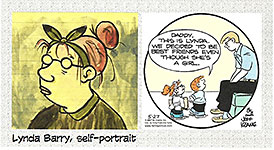
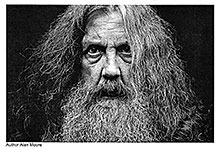

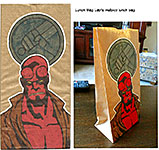
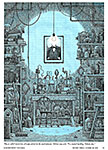
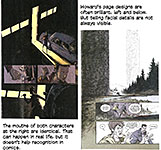
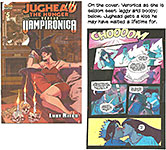
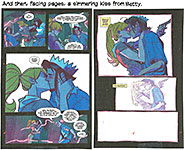
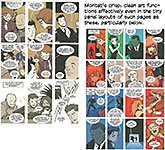
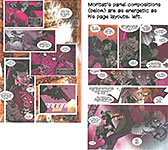
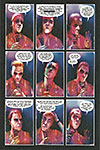
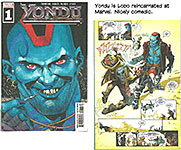
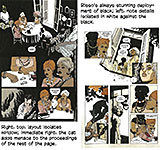
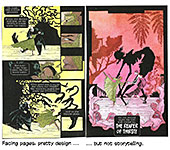
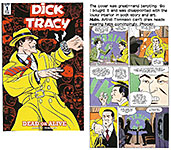
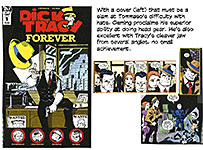
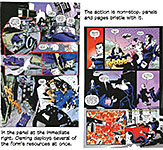
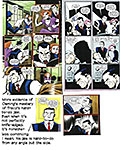
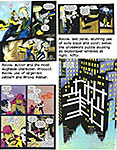
1.jpg)
2.jpg)
3.jpg)
4.jpg)
1.jpg)
2.jpg)
3.jpg)
4.jpg)
5.jpg)
6.jpg)
7.jpg)
8.jpg)
9.jpg)
10.jpg)
11.jpg)
1.jpg)
2.jpg)
3.jpg)
